Affiliate Disclosure: If you buy something through some of the links on this post, you won’t pay any extra, but we’ll get a small commission. This helps us keep things running. Thanks for your support!
Stealth Battlers are … back!! Just kidding.
B-169 Starter Variant Lucifer.Mb 2D actually has some redeeming qualities. Find out why you should consider adding it to your collection for tournaments in my complete Beyblade review below.
I cover each of its parts in detail, dive deep into both the history of the game surrounding stamina and defense types, and talk about the trends I’ve observed in Takara-Tomy’s design process over time.
B-169 Starter Variant Lucifer.Mb 2D (バリアントルシファー.Mb 2D) is the second defense type released in Beyblade Burst Sparking. Each of its parts are brand new to the series and it comes packaged with a black Sparking BeyLauncher.
Product Details
- Brand: Takara-Tomy
- Product Code: B-169
- Product Type: Starter (Sparking BeyLauncher Included)
- System: Sparking Layer System
- Series: Beyblade Burst Sparking (Superking)
- Type: Defense
- Spin Direction: Right
Where to Buy Variant Lucifer Mobius 2D
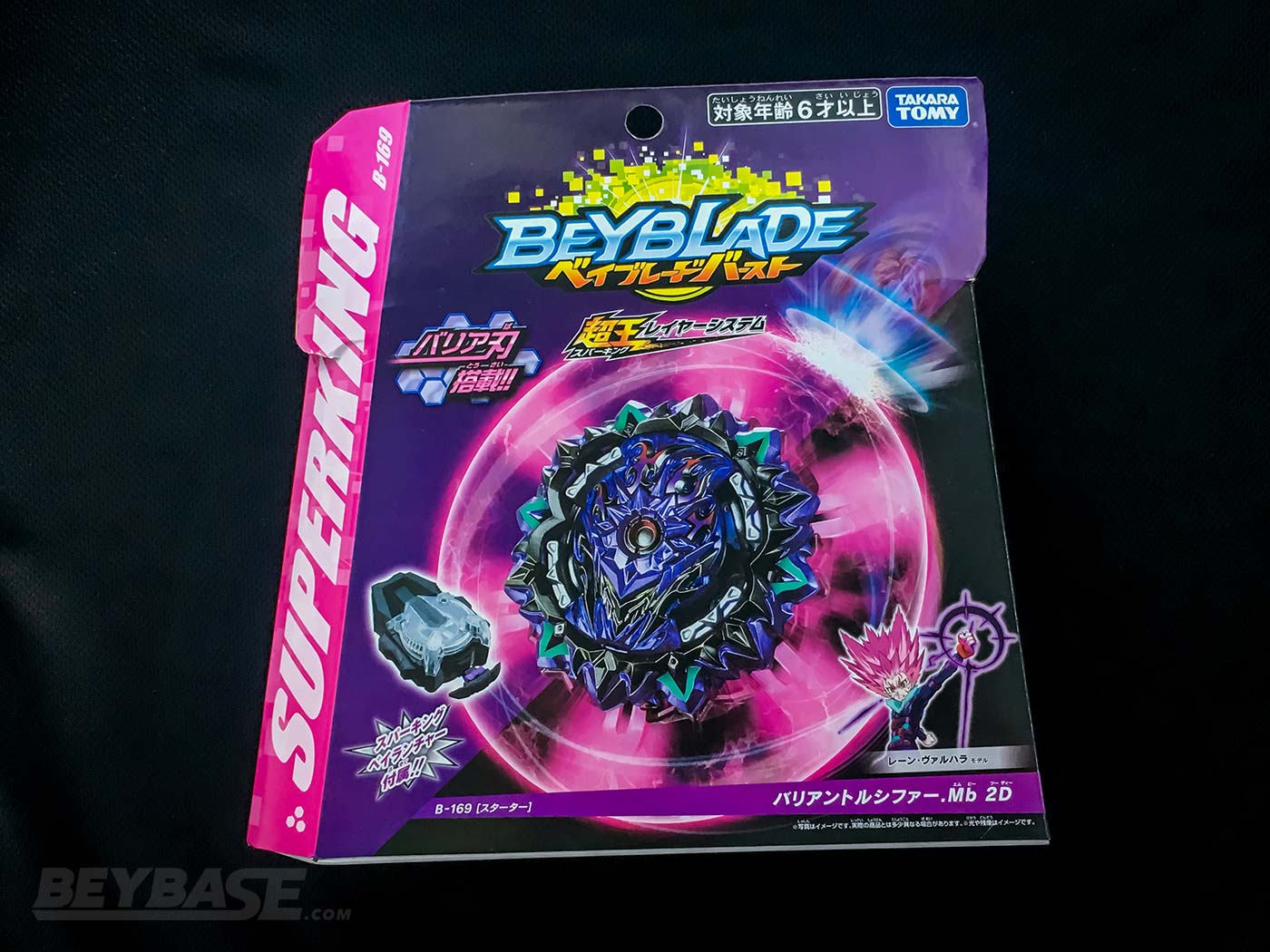
Heads up: If you buy something through some of the links on this post, you won’t pay any extra, but I’ll get a small commission. This helps me keep things running. Thanks for your support!

25 years. 4 generations. And we still don’t know: is Beyblade a sport? A toy?
I wrote a 100 page article to answer this question.

Sponsored: Order the newest Beyblades at malloftoys.com!
Heads up: If you buy something through Mall of Toys, you won’t pay any extra, but I’ll get a small commission. This helps me keep things running. Thanks for your support!
Variant Lucifer Mobius 2D Parts
Sparking Chip: Lucifer (Lc)
- Weight: 5.56g
Lucifer Sparking Chip Summary
With built in metal components, Lucifer is heavier than regular Sparking Chips, making it a useful alternative to them if you are unable to find the rare Metal Chip Core. Lucifer is a strong choice for basically all right-spin combos.

The Lucifer Sparking Chip is notable for being the first Sparking Chip to have the Chip Core fused into the chip itself.
Heaviest Sparking Chip To Date
The purple design surrounding the centre of the chip representing a purple sun is made of metal as well, making this the heaviest Sparking Chip out of the box to date.
There is a Metal Chip Core available for the regular Sparking Chips like the ones found with Super Hyperion and King Helios, but at the moment it is difficult to obtain, so Lucifer is the easiest way to add some additional weight to your Beyblade without seeking out the Metal Chip Core.
Takara-Tomy’s Ongoing Trend of Fusing Layer Parts
While the design of Lucifer is great aesthetically and having an easy way to obtain a heavier Sparking Chip is welcome, it did strike me that the combination of the Sparking Chip Core with the Sparking Chip continues a trend that began in 2017 with the release of Legend Spriggan 7 Merge.
Legend Spriggan had a metal core built into the centre of the Layer itself rather than allowing for one of the detachable God Chips or a Metal God Chip.
In Beyblade Burst GT with releases like Venom Diabolos Vanguard Bullet and Lord Spriggan, the Diabolos GT Chip and Lord Layer Base didn’t allow for a standard feature of that season’s system–Layer Weights–to be used with them.
This reduces customization, which I’m not sure is the best way to go about things in a game which prides itself on the amount of customization available.
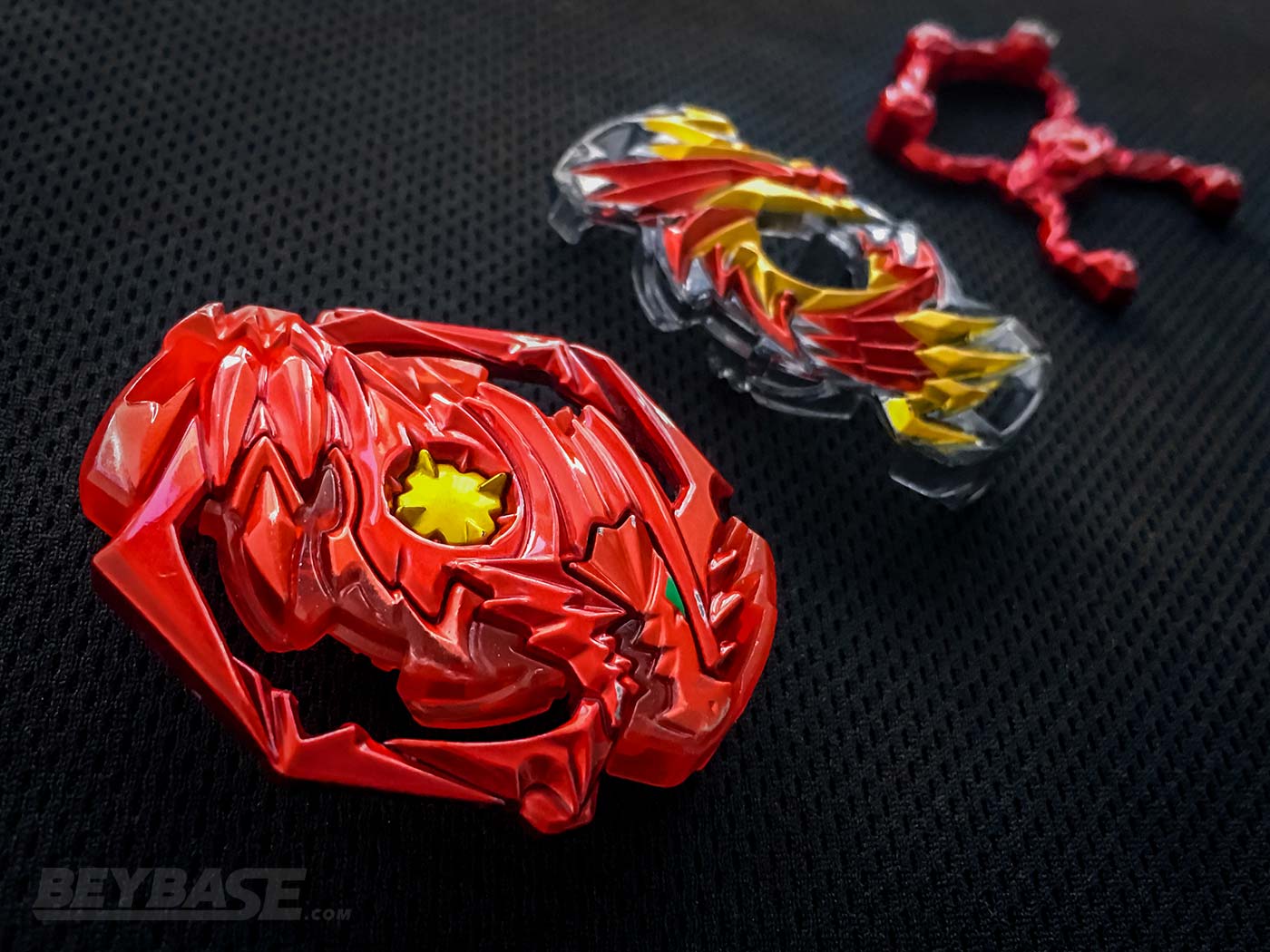
In the case of Diabolos the argument could be made that it presented an interesting competitive choice to players given that it was among the heaviest of the Chips + Layer Weights. Conceptually, making the choice between being able to choose your weight distribution or more weight is a good one (although the rare Goku Weight + a GT Chip likely comes close to the weight of Diabolos, making this a bit of a moot point).
But in reality, Diabolos was often used as the default GT Chip in most cases for competitive players on Layer Bases like Zwei and Judgement. The other most competitive GT Layer was Lord, which didn’t accept a Layer Weight … so that meant that situations where separate Layer Weights and GT Chips actually mattered were fewer than they probably should have been with it being a defining feature of the system in that season.
Their importance does vary depending on the rules you play with–WBO, WBBA, or otherwise–but it is something which affected the metagame to different degrees in all cases.
Ring: Variant (V)
- Weight: 5.84g
Variant Ring Summary
Variant synergizes well with the included 2D Chassis, but is the lightest Ring yet. This alone sadly makes it basically useless. It has no redeeming qualities in terms of attack, defense, or stamina. This is the part you can most easily skip from this release.
Variant is a defense type right-spin Ring with a circular design adorned by various sloped short spikes of varying sizes around its circumference.
Six larger green spikes protrude further than the others. When combined with the included 2-Defense Double Chassis, these spikes are positioned above and between the pink rubber blades of 2D. Variant and 2D continue the trend of brand new Ring and Chassis’ being clearly designed with each other in mind (similar to Brave and 2A or Rage and 3A).
Variant’s synergy with 2-Defense is about as far as I can praise this Ring, however.
The Variant Ring’s Poor Stamina
In practice, Variant has very little stamina to speak of and subpar balance. This makes it a poor choice over other existing options for both same spin and opposite spin stamina combos.
In combination with 2D and Mb it works fine for opposite spin matchups because of the synergy with 2D, but outside of that I have yet to find a legitimate use for it.
When paired with Chassis like 2A it does expose a bit more of the Chassis’ contact points because some of the spikes are further inset than others, but this doesn’t seem to provide any notable benefits.
Variant is the Lightest Ring Available
To top it off, at 5.84g it is the lightest Ring available. Lighter than even First which comes in at 6.08g. Most Rings range between 8-12g.
Ultimately, it seems like this piece was designed more so to be a showpiece than something which could be used for competitive battles in the current metagame.
This has become a little bit of a frustrating trend throughout the beginning of not only Beyblade Burst Sparking, but Beyblade Burst GT and the whole series, frankly.
Not every part can be top tier, but when you knowingly design something which is far lighter than its contemporaries–like Variant–or make its lock with Drivers laughably weak–like Glide–it makes me wonder how the design process works at Takara-Tomy.
What disadvantage would there have been to at least making Variant 8 grams, for example?
How does Takara-Tomy Balance Performance, Aesthetics, and Cost?
I wonder, what is the balance they strike between performance, aesthetics, and cost during the design process?
If they had made Variant 8 grams for instance, it may have had a better chance of being useful for something and still been within the range of other existing Rings in the series.
The lightweight of Variant seems like it could be a result of them considering the weight of Variant plus the above average weight of Lucifer together rather than separately, which I think is a mistake from a competitive point of view. If Lucifer weighed two grams less and was as heavy as most Sparking Chips, Variant could have been 8 grams and fit in closer with its contemporaries.
Given that this is a starter which includes complex parts like 2D and Mobius as well as the likely expensive to manufacture Sparking BeyLauncher, it’s possible cost considerations could have played a part in what we’ve ultimately been given with Variant.
Although, I won’t pretend to fully understand the area of toy manufacturing costs myself.
While context is always key with Beyblade in terms of performance–as is demonstrated by alternative organized play formats like WBO’s Burst Classic and Burst Limited Formats–what players are left with nevertheless in the here and now of the standard Beyblade Burst metagame is another frankly useless part.

Sponsored: Order the newest Beyblades at malloftoys.com!
Heads up: If you buy something through Mall of Toys, you won’t pay any extra, but I’ll get a small commission. This helps me keep things running. Thanks for your support!
Chassis: 2-Defense (2D)
- Weight: 47.06g
2D Chassis Summary
Heaviest Chassis available to date, but pitiful stamina and also defense in same-spin battles despite the innovative extending rubber blade concept. Its potential instead lies in wearing down the rubber blades. This turns it into a much more aggressive Chassis with potential for attack types.
2-Defense is a defense type Double Chassis with a thick, ridged design, centralized weight, and a unique gimmick which extends six pink rubber blades to absorb incoming attacks during battle.
When the rubber blades are extended, 2D is the widest part available in Beyblade Burst.
The thickness and shape of 2D is somewhat reminiscent of the Wall Frame from Beyblade Burst Cho-Z.

What is a Chassis?
For those unfamiliar with Beyblade Burst Sparking, the Chassis is a brand new part type. It combines with the Ring (similar to the Layer) and Sparking Chip to create a solid piece.
The Chassis also carries the teeth mechanism which makes the Burst System work.
There are two types of Chassis:
- Single Chassis: Compatible with all existing Disks.
- Double Chassis: Not compatible with Disks due to their vastly increased weight, like 2D.
The Evolution of Attack, Defense, and Stamina in Beyblade Burst
As I’ve spoken about in my “The Top 5 Best Beyblade Burst Combos (Selected by Expert Players & Organizers)” article, the Beyblade Burst competitive scene was largely dominated early on by defense/stamina hybrid combos.
It wasn’t until 2019 really with the release of Judgement Joker and Zwei Longinus in combination with the previously released Xtreme’ Driver that attack really became a legitimate and consistent threat.
Throughout the past five years since Beyblade Burst began however, pure defense types have been practically nowhere to be found.
Defense was often a bonus of a combo with strong stamina or a result of being on a fast-moving Driver like Unite’ which allowed it to avoid some attacks.
There haven’t really been many situations where stationary pure defense types have felt powerful and viable.
The Keep’ Driver has improved the outlook, but being ball-shaped, even that Driver is mobile to some degree and relies on the grip of its rubber.
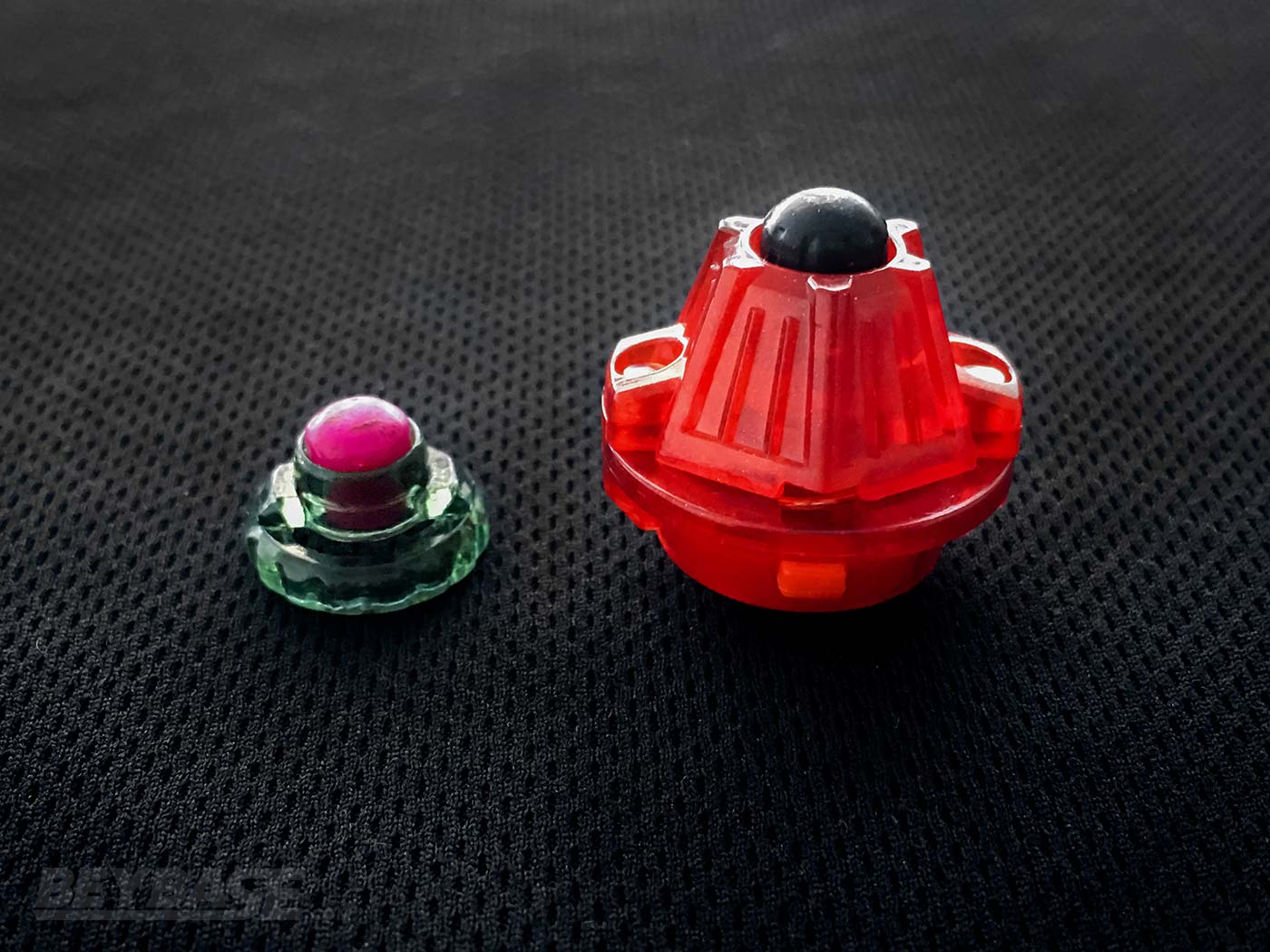
Similar to the Rubber Ball bottom from Metal Fight Beyblade, it even sees use in attack type combinations when worn down and is able to destabilize some opponents in same spin direction battles, so it’s hard to look at it as being pure defense.
Nevertheless, in tandem with Layers like Archer Hercules or Master it can be formidable defensively.
Examining the Concept of Stationary, Weight-Based Defense Types
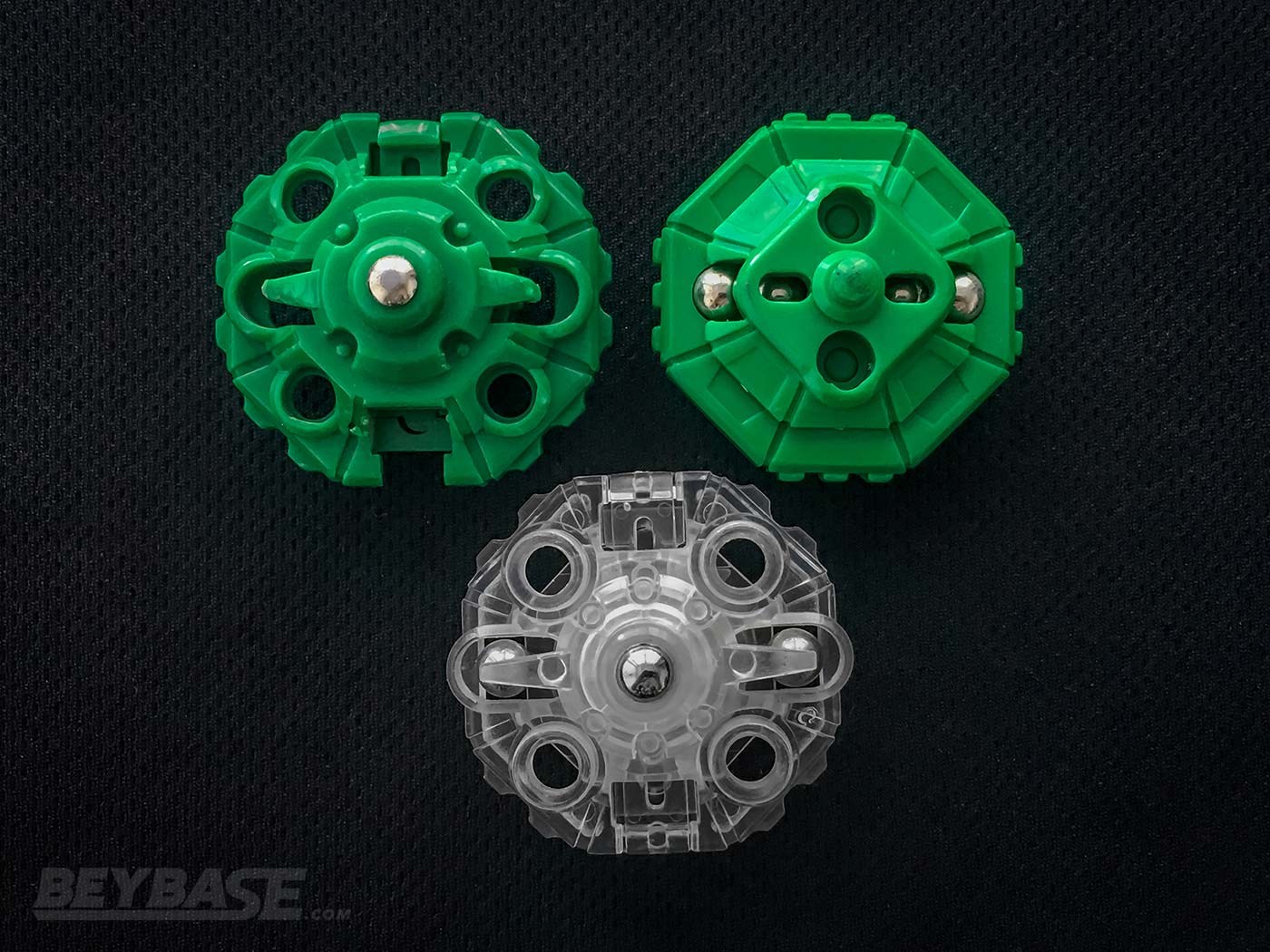
In the plastics generation there was this concept of weight-based defense using parts such as the SG Metal Ball Base from Draciel S; it came with one set of metal balls inside the Blade Base as part of the gimmick, but you could actually add a second pair if you had them to increase the weight of it.
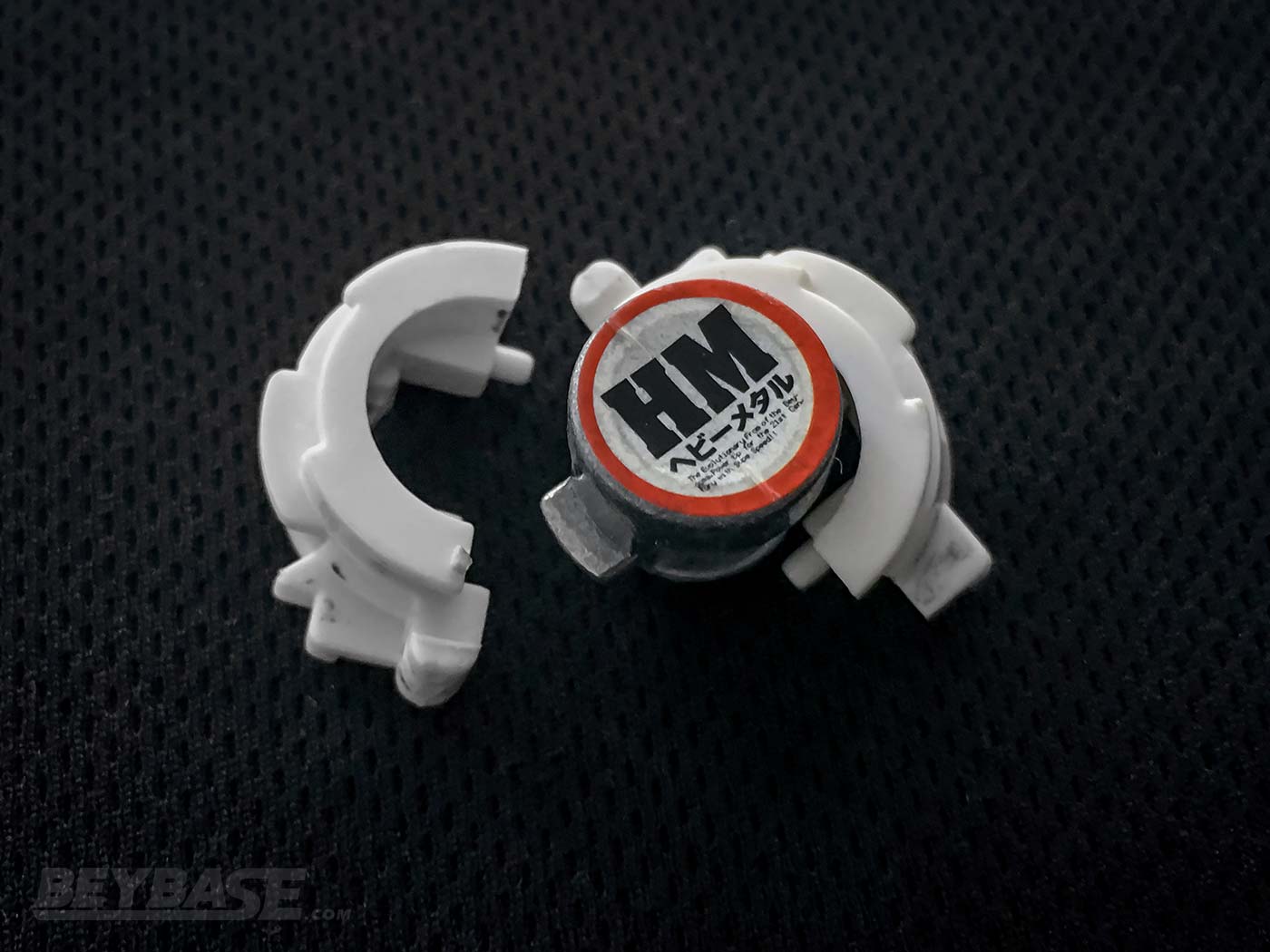
This, in addition to using a Heavy Metal Core in your Spin Gear helped to make it heavy enough that the weight became a factor when lighter attack types came up against it.
Beyblade Burst hasn’t explored this concept beyond the introduction of heavier Drivers like Ωcta (which didn’t significantly enable the weight based defense concept to be viable).
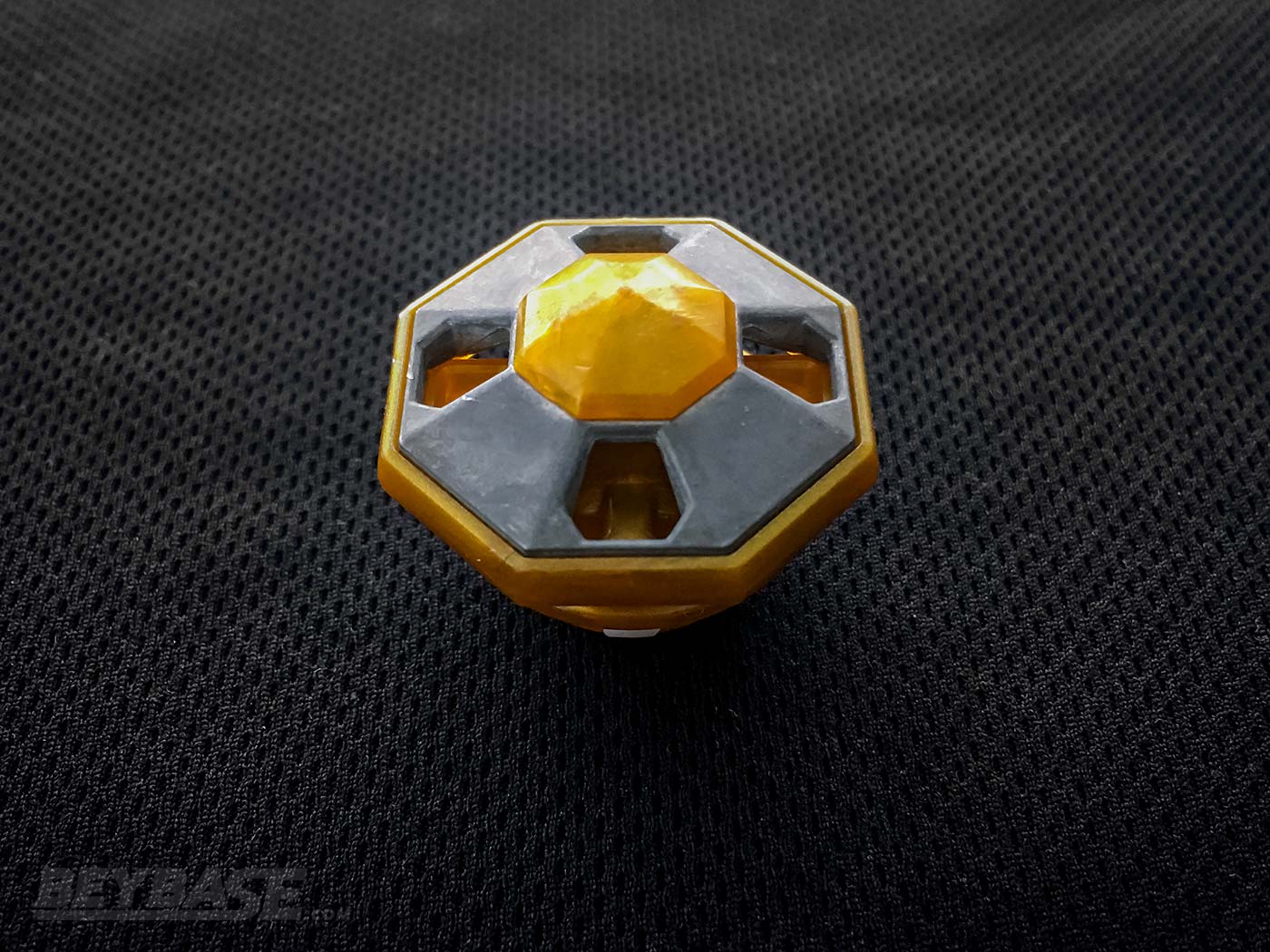
Part of the problem with the concept of stationary pure defense types in Burst is that they are inherently risky.
By being stationary and designed to take hits you open yourself to being hit more strongly, which naturally increases your chances of bursting. This is because most contact will be made with your Layer, the piece which is most likely to cause your Beyblade to begin skipping the teeth of the burst mechanism.
One way to solve this might be to use taller combos on things such as Bullet, which is heavy and taller than most Drivers. This reduces contact with the Layer to a degree.
I’ve tried employing this strategy before with Perfect Phoenix Ratchet Bullet. While fun and interesting to use, it admittedly wasn’t terribly consistent.
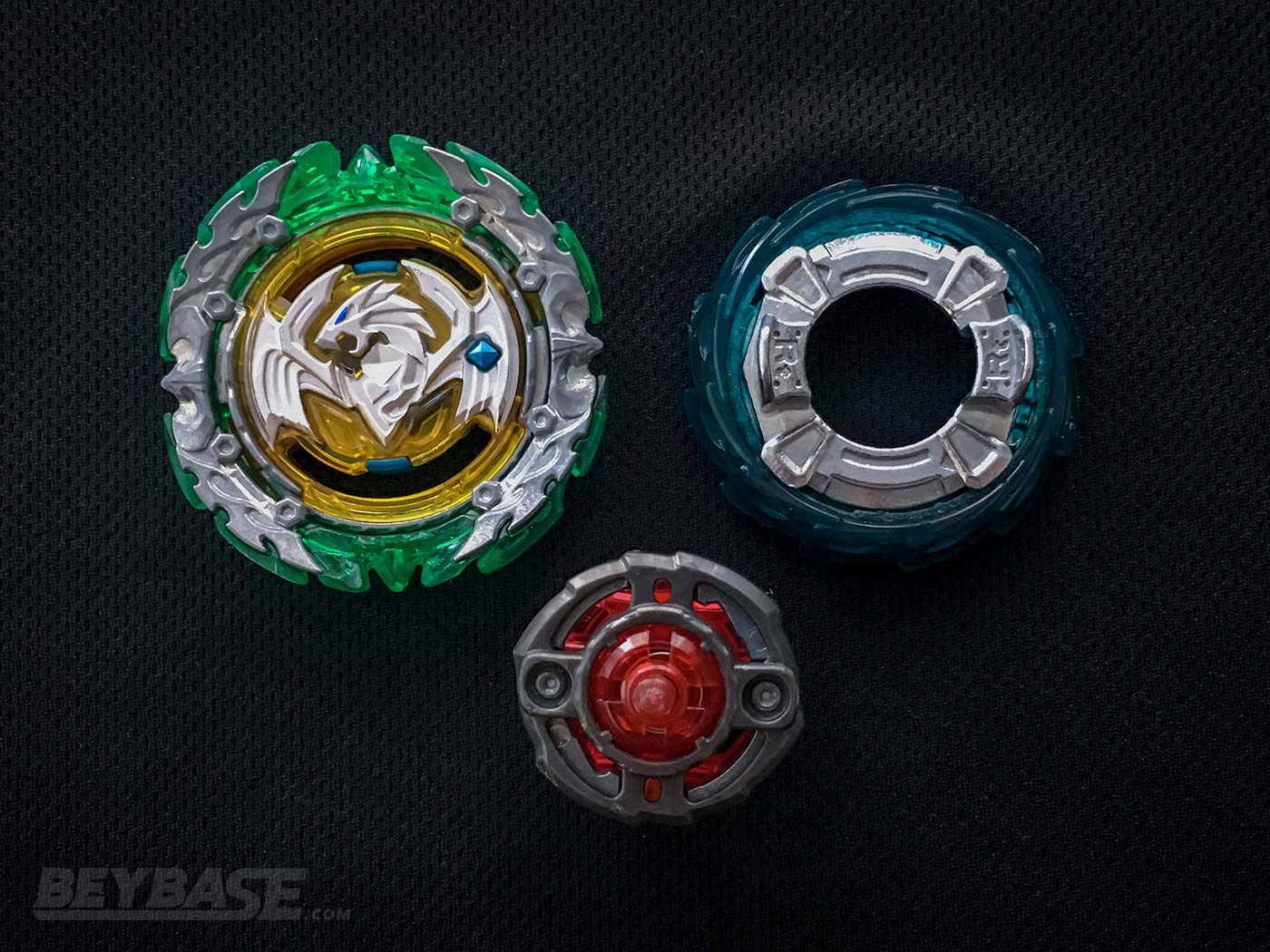
In previous generations of Beyblade, bursting was not a consideration, so defense types were solely designed to resist being KOed and have enough stamina to outspin attack types.
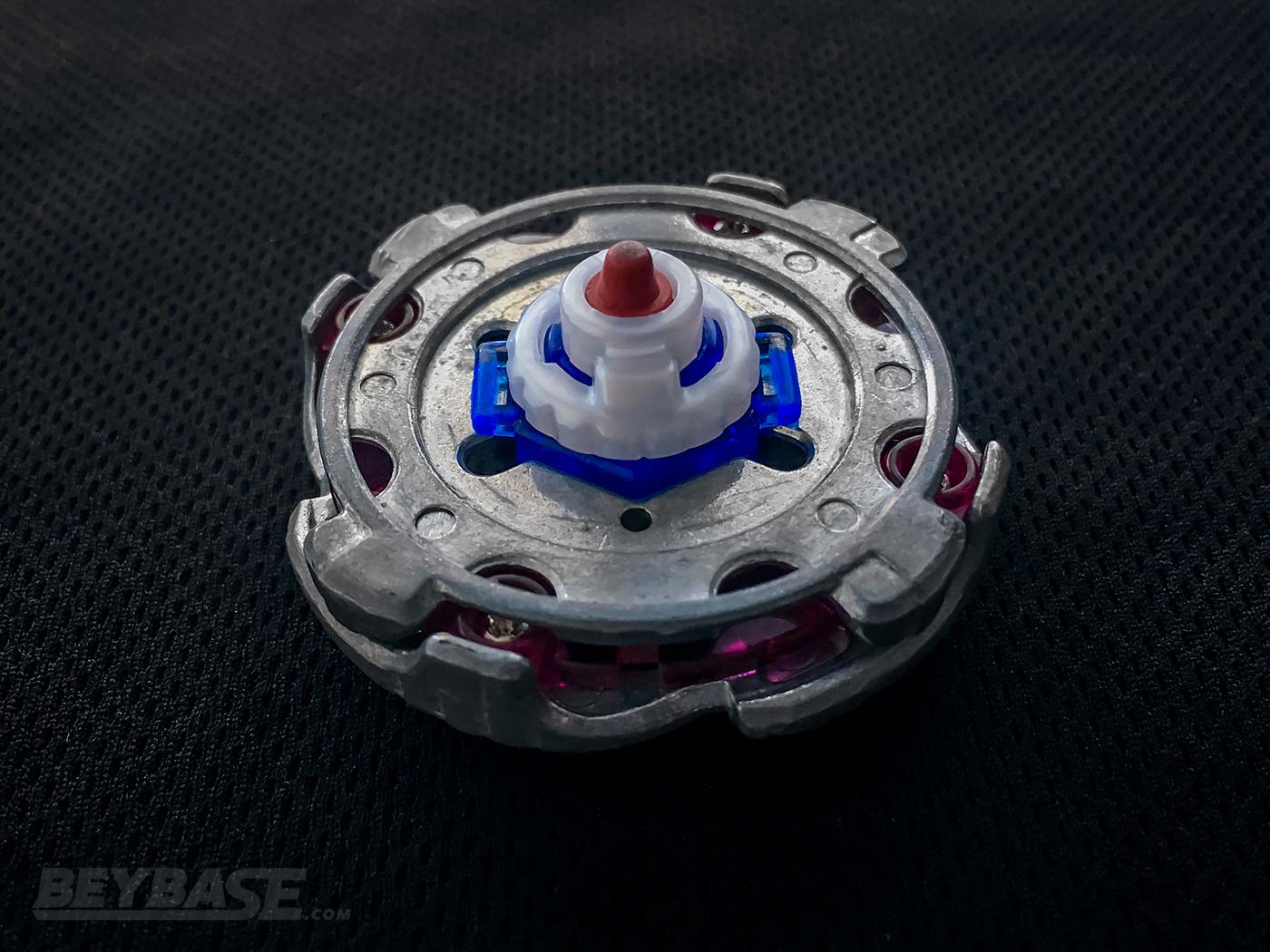
One of my favourite examples of this is MF-H Jade Uranus 90RS, which is both heavy due to MF-H and Jade and stationary due to the Rubber Sharp Bottom. I’ve used it to help me win multiple WBO Metal Fight Limited Tournaments over the years.
Introducing Barrier-Based Defense
And so, where does 2-Defense fit into all of this?
The six pink rubber blades which extend during battle create a force field of sorts around your Beyblade which absorbs and dissipates the impact of some incoming attacks.

Takara-Tomy has jokingly referred to Variant Lucifer.Mb 2D as the first “social distancing Beyblade”, which is hilarious and entirely accurate.
Up until now defense has always been about either evading your opponent or being able to take direct hits. This is really the first time we’ve had a defense type part designed around the idea of creating a literal barrier around itself and pushing opposing Beyblades away from touching its main body directly.
At lower spin speeds, the blades retract to help reduce scraping and loss of stamina at the end of the battle. This works well in combination with the free spinning Mobius Driver included with Variant Lucifer. It’s a smart design.
The blades extend upwards as well, which can contribute to destabilizing opposing Beyblades on lower Drivers. Extending upwards is also beneficial for stamina as it reduces the amount of scraping at the end of a battle. This is important given how low-hanging 2D is.
A Barrier with Purpose

We’ve seen parts with wide pieces which extend far beyond the typical circumference of a Beyblade before–one can be seen with the free-spinning ring of Gaia Dragoon from the original plastics generation which was remade for Beyblade Burst–but none have seemed to ever be as well conceptualized as the rubber blades of the 2-Defense Chassis.
It feels like the barrier they create has an actual purpose.
The Problems with the 2D Chassis
I’ve sung the praises of the concept behind 2D, but does the concept translate to competitive usage?
Well, not really.
Poor Same Spin Stamina Performance
One of the problems with the rubber blades is that they kill the same-spin stamina of the Beyblade using them quickly. This problem is especially pronounced when used in tandem with the Mobius Driver, which has abysmal same-spin performance.
If an opposing attack type is able to get a few strong hits onto the 2D Chassis-wielding Beyblade, there’s a good chance that at least one of them will be a critical hit which drains your stamina significantly.
Pure defense types aren’t meant to have a ton of stamina, but they should be able to outspin pure attack types. This often isn’t the case with 2D in same-spin battles.
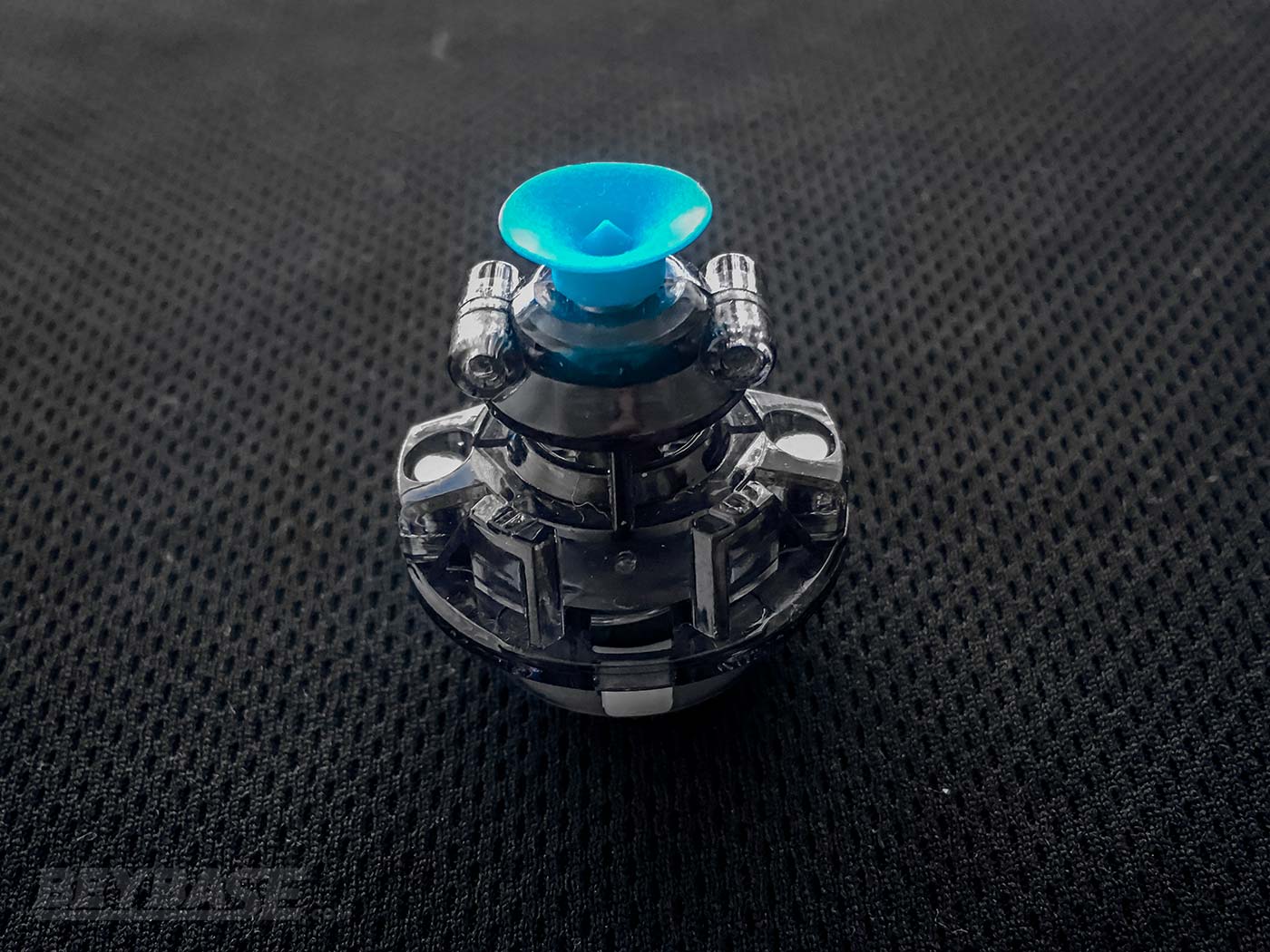
In a sense, it shares this trait with the Quest Driver. Quest has pretty clearly the best pure defense in the game–it’s very difficult to move because of the rubber suction cup tip–but it also has practically no stamina to speak of, making it virtually useless for that purpose.
Ineffective Tornado Stalling
When using a Driver with a decent amount of movement that can stall near the tornado ridge circling the inner area of the stadium, the extended rubber blades can scrap against the floor. This contributes to the above problem and limits the realistic choices for this Driver to be used.
Poor Defensive Performance
Although the rubber blades do dissipate some impact of incoming attacks, they don’t dissipate all of it. When they don’t, the attacking Beyblade pushes the blades inwards and makes contact with the bumpy central piece of 2D, which has the potential to cause the spin killing recoil I’ve referenced above.
Additionally, the combined width of the rubber blades is shorter than the combined width of the bumpy plastic areas between them. This means there is a greater chance of the opponent hitting the inner piece than the rubber blades when a strong hit is delivered.
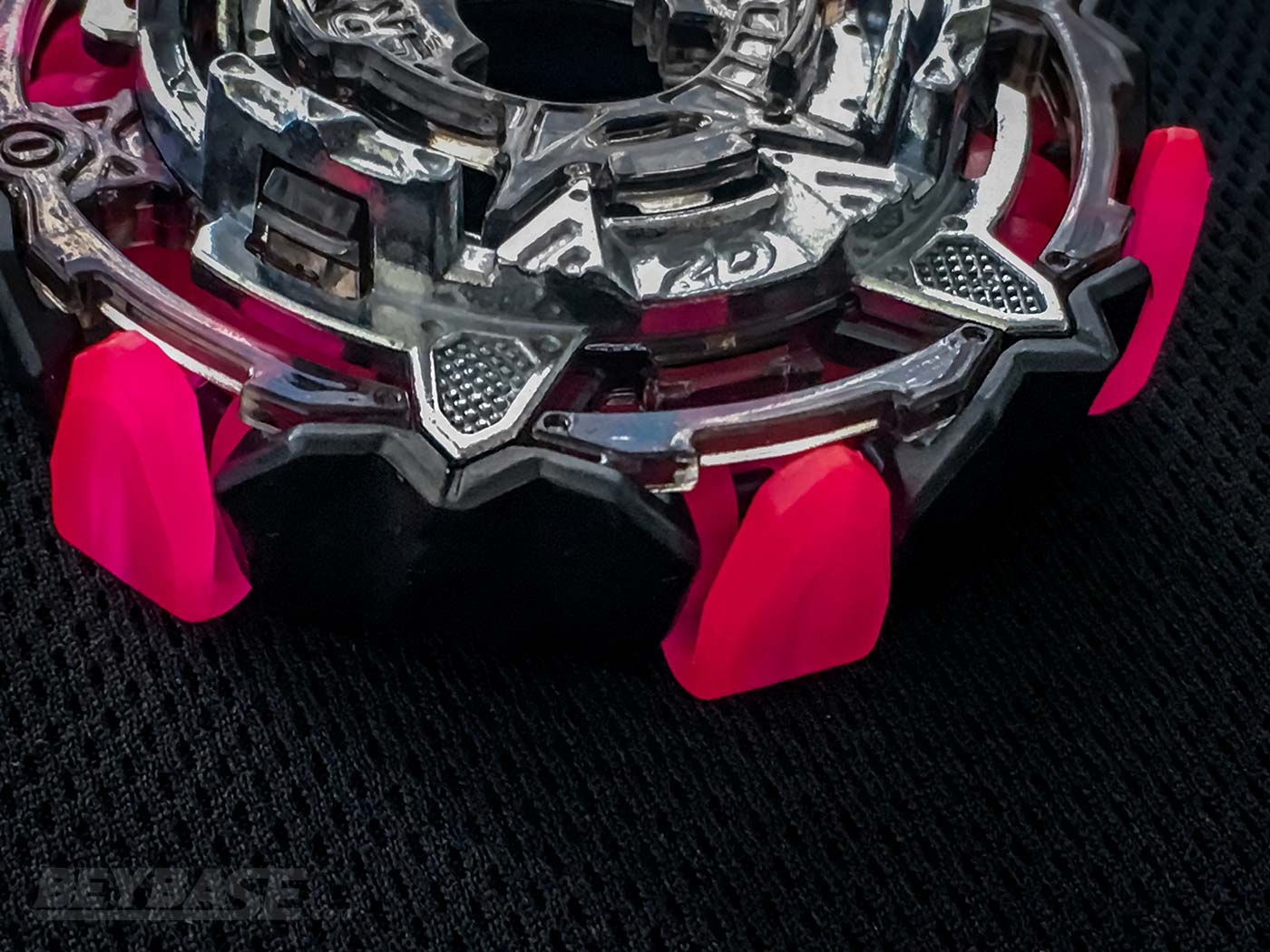
Defense Drivers like Quest, Ωcta, or Keep’ also aren’t enough to make 2D viable defensively.
Quest exacerbates the poor stamina problem and can be KOed easily by the likes of Zwei.
Ωcta and Keep’ are actually solid defensively with 2D, but the stamina problem is just too great for it to be viable. Both of these Drivers are also shorter than Quest or Mobius, so the low-hanging nature of 2D becomes a greater factor here.
There appears to be a dissonance between what the rubber blades are trying to achieve and what the inner plastic piece of the chassis produces.
It would have been more cohesive conceptually and likely a bit more effective in reality if the inner piece was smoother and the rubber pieces were wider.
Scrapes Quickly on Standard Height Drivers
As mentioned above, 2D hangs relatively low compared to other Disks and Chassis. This means when paired with Drivers that are standard height, it scrapes the stadium floor quicker.
This contributes to its poor stamina in same spin battles and pushes players toward using taller Drivers like the included Mobius.
It is likely a design choice Takara-Tomy made knowingly in order to limit 2D’s effectiveness … but they probably went too far.
“Awakened” 2D: The best “defense” is … offense?
2D’s barrier can be broken quite literally too.
After extensive use the rubber blades can tear offer in battle one-by-one, eventually leaving the Chassis in its “awakened” state with no rubber blades.
Mack the Burst on Youtube has demonstrated how to “awaken” the 2D Chassis:
In this state, all contact is made with the jagged design of the central part of the chassis.
Peter Pig on Youtube has posted a video demonstrating how the awakened 2D Chassis performs:
His video demonstrates that in this state, 2D has a stronger ability to retain its stamina. As a result, it is then in a better position to take advantage of its recoil and become closer to being and attack type Chassis.
In fact, Takara-Tomy advertises this performance change in the instructions included with this release.
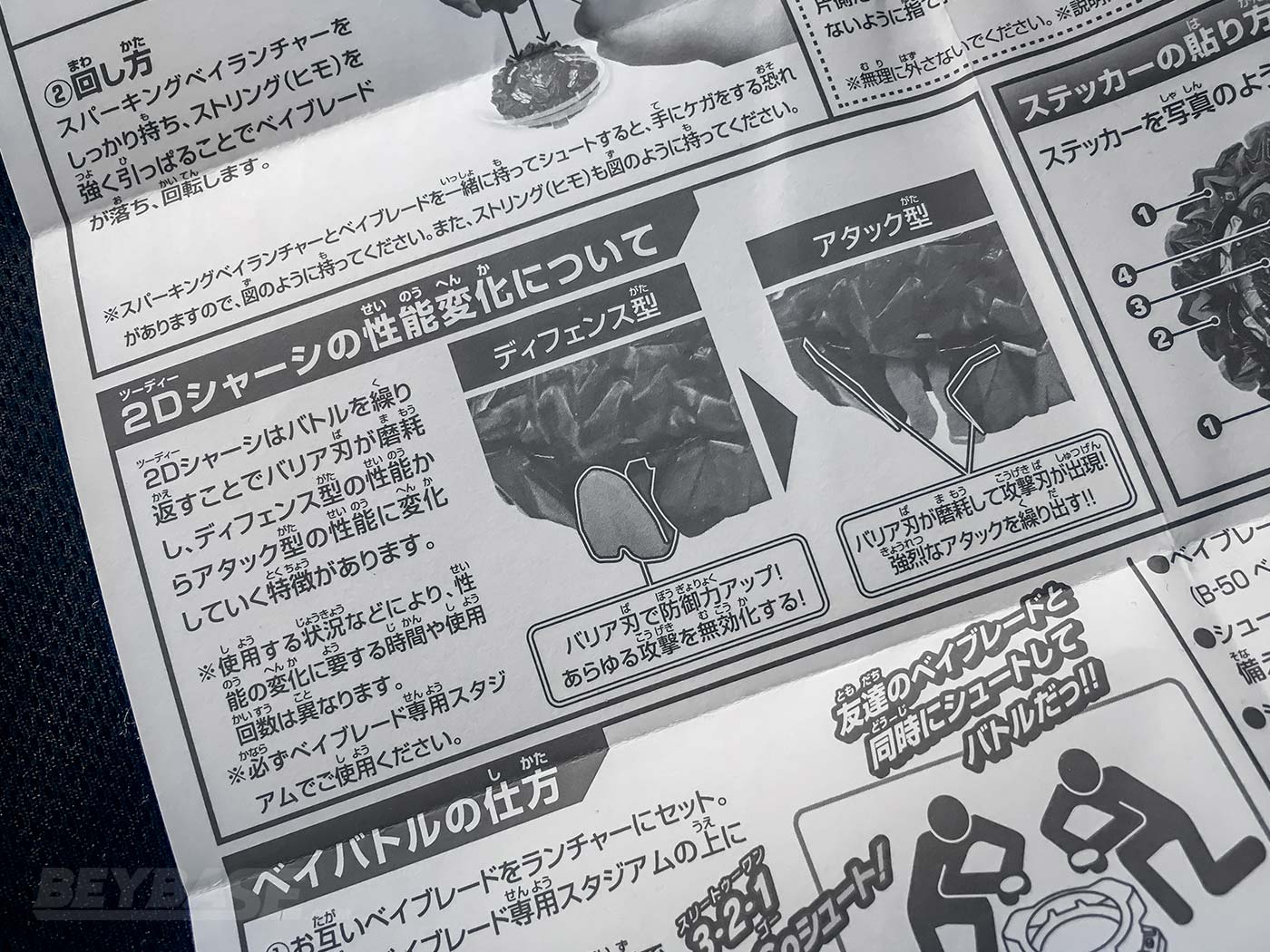
To me, this explains the dissonance between the defensively minded rubber blades and the offensively minded exterior plastic inner piece.
It’s more marketable I guess to make a dramatic shift from defense to attack than it would be to make the inner piece smoother and more defensive and have to say “The blades break off and well … it’s still a defense type!”.
Takara-Tomy’s Intentional Part Wear Feature Trend
Part wear and changing performance is nothing new in Beyblade.
However, my impression over the past several years has been that Takara-Tomy has placed a conscious effort on employing this idea when designing some parts.
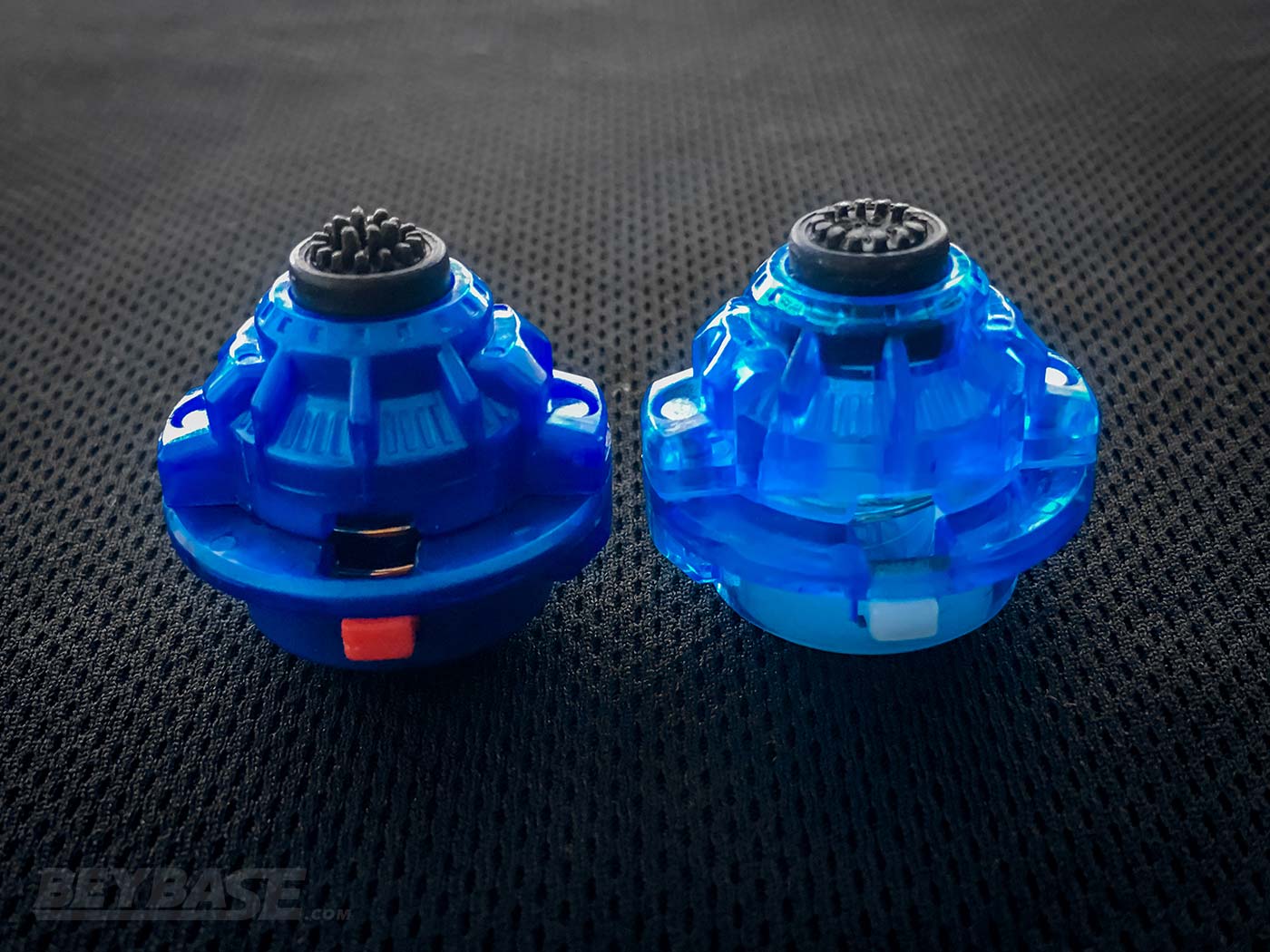
The first example of this was Variable, whose multi-level spiky rubber tip was designed to wear down bit by bit making it eventually into an extremely wide rubber flat tip. This idea was re-used with parts like Evolution.
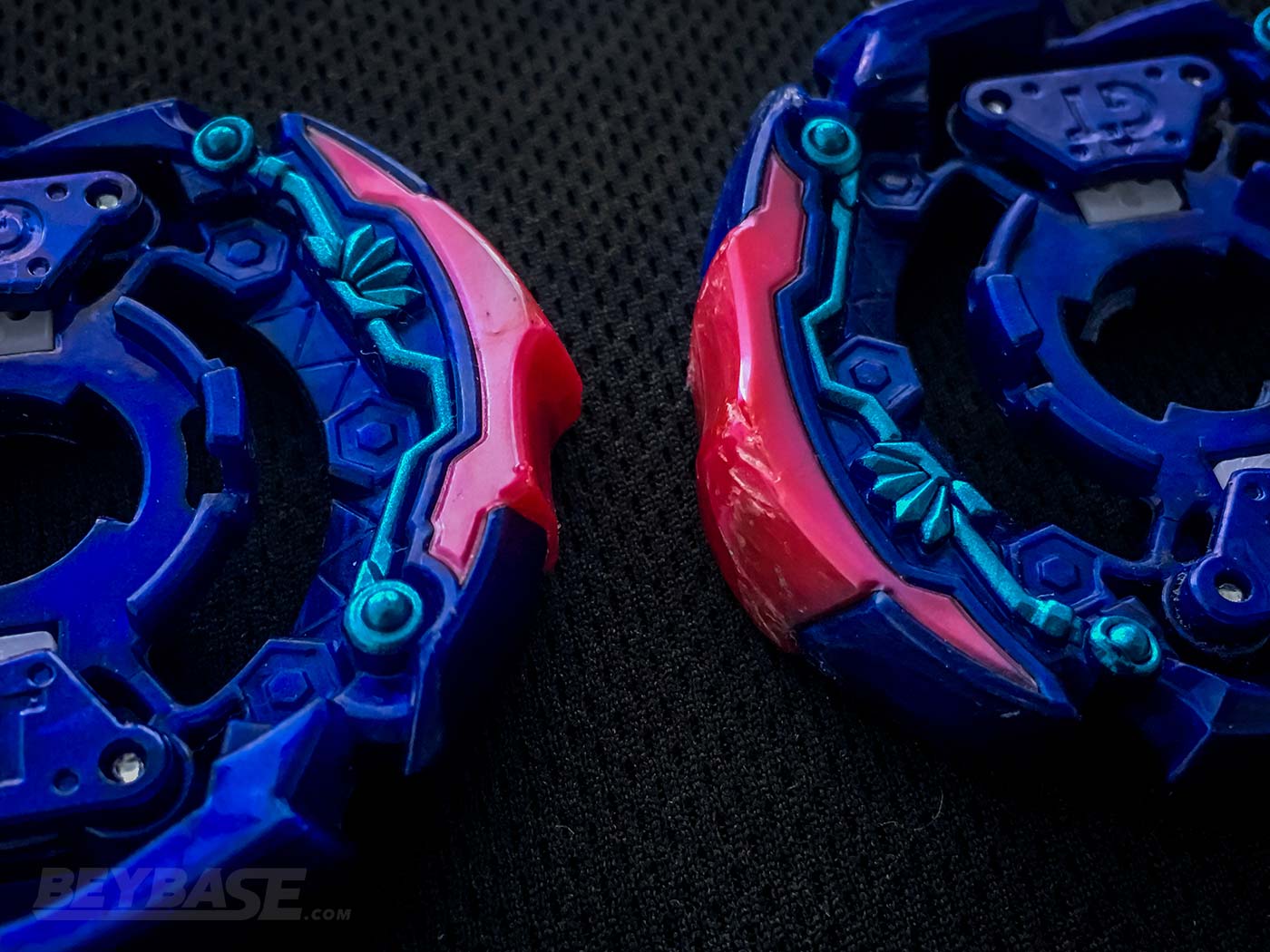
Parts like Judgement and its massive rubber attack points clearly must have been understood to wear over a relatively short period of time through use as well. The same can be said for the burst stopper tabs on the interior of the Lord Layer Base.
Even parts that aren’t really designed overtly with the idea of wearing them down for differing performance–like the plastic tips of Bearing or Ignition’–have become popular to wear down and “awaken”. Especially in Japan.
With 2D, this trend continues as described above.
How far is too far when it comes to part wear?
I’m of two minds on this.
On one hand, I think it’s brilliant. The idea that parts can change in performance over time and that the player has control over this to make their part different from their opponents and gain an edge in battle–if used strategically–is great.
It’s also to a certain degree an unavoidable element of Beyblade; being a physical game where tops collide with each other and parts grind against the stadium floor, part wear is inevitable.
On the other hand, it seems exploitative because Takara-Tomy does not always make parts easily accessible.
If a part is going to be designed to wear down quickly, it should be available separately because at that point it effectively becomes a disposable item once it wears past the point of being competitive.
In the case of 2D it does take several hours of sustained violent use to make the blades fall off, but the point still stands on a general level.
There’s also a part of me that is bothered by it because it makes the game that much more complex. It’s one thing to test and understand how a particular part works in general, but it’s another to have to try and understand every possible permutation of a part that could be used against you in a tournament.
So, I’m torn in the end: I love the creativity and individuality part wear brings, but if parts aren’t released separately so they can be easily bought and consumed in large quantities, it feels exploitative.
And the endless possibilities afforded by affording greater latitude for legal part wear makes it exponentially more difficult to truly prepare for and predict results in some cases.
This might make things more entertaining in some cases, but I’m not sure it makes things more competitive. It just means whoever has the most time and best means available to wear parts (in Beyblade Burst that’s the expensive Cho-Z Musou BeyStadium, as Mack the Burst has demonstrated here) and test their parts in each permutation will ultimately have a better chance of understanding how to win.
They certainly deserve it for putting in the time, but I wonder if the increased latitude for wear makes the game more difficult to approach for new players seeking to play competitively and even existing competitive players who might have the time needed to test, but not the time to dive quite so deep into testing an infinite amount of wear levels or spending hours trying to “awaken” a specific part (especially if they don’t have the Cho-Z Musou BeyStadium) without really understanding if the investment will be worth it.

Sponsored: Order the newest Beyblades at malloftoys.com!
Heads up: If you buy something through Mall of Toys, you won’t pay any extra, but I’ll get a small commission. This helps me keep things running. Thanks for your support!
Rare Red 2D Chassis
Finally, I should also mention that there is a small chance (1/72, I believe) of pulling a rare version of the 2D Chassis with the inner metal piece painted red!
I was lucky enough to pull one myself!
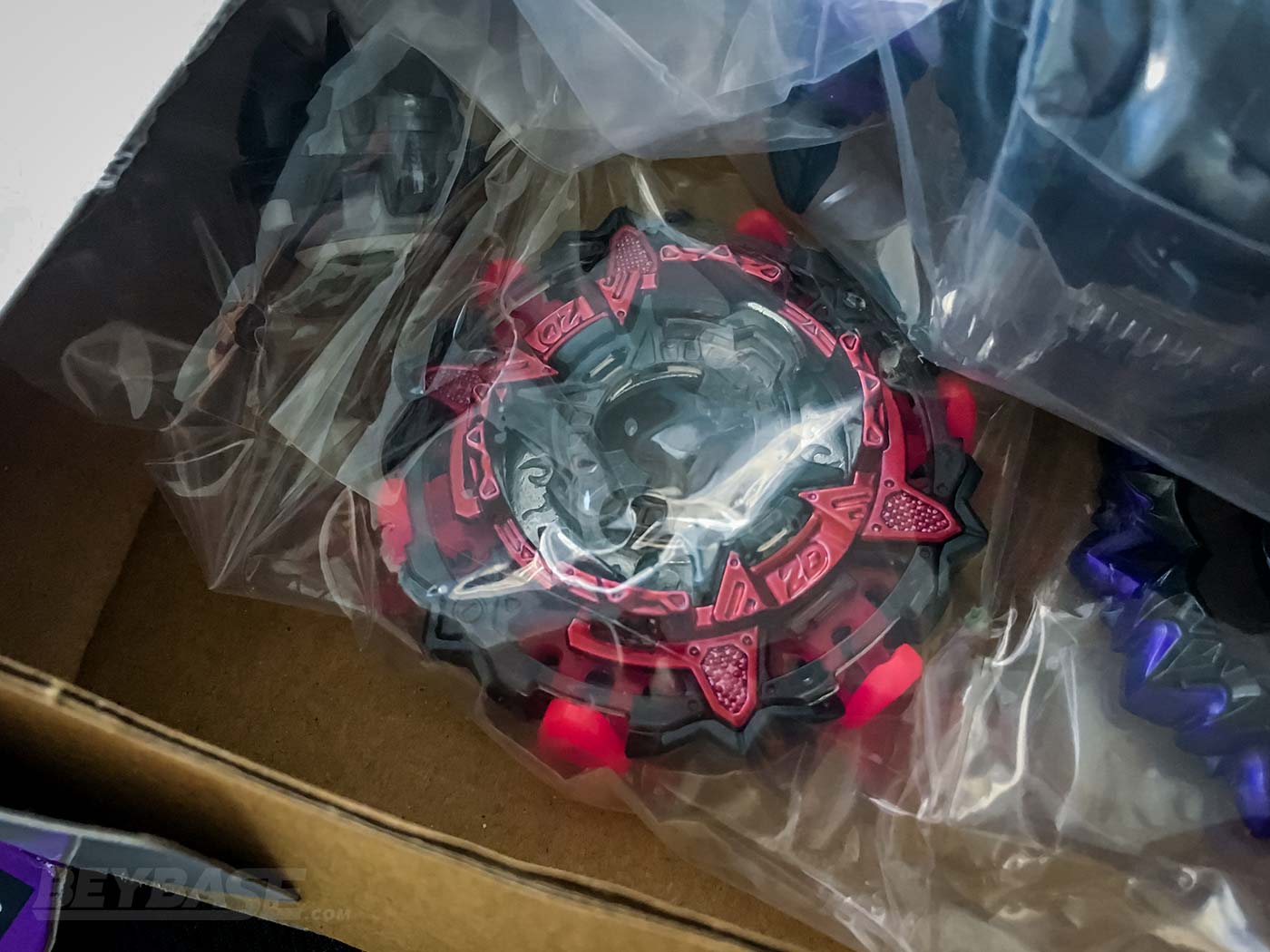
Driver/Performance Tip: Mobius (Mb)
- Weight: 7.68g
Mobius Driver Summary
Top tier stamina Driver for opposite spin battles. Poor same spin performance. Every competitive player needs this Driver!

Mobius continues the theme of including design features with six components seen in the Variant Ring and 2D Chassis. It features six thin, tall spikes emerging from the bottom of the standard Driver shell that end in a point just before the tip begins.
Resemblance & Differences Versus Bearing Driver
The tip of the Mobius Driver bears a striking resemblance to the ultra-competitive Bearing Driver. But there are many key differences.
Free-Spinning Circular Plastic Disk
Like Bearing, the tip itself is a wide, circular, white, free-spinning plastic disk made from POM (Polyoxymethylene) which has lower friction than regular plastic against the stadium floor, increasing stamina.
It is however much flatter than Bearing and instead of a pointed, sharp centre, Mobius features a small rounded ball-shaped tip.
Plastic Washer in Shaft
Mobius features a plastic washer around its shaft instead of a bearing.
Using a bearing would have afforded this Driver even higher stamina, but the plastic washer does nevertheless enable the tip of Mobius to efficiently spin freely towards the end of battles when it is tilted.
Tall Height
The tall height of Mobius is also another differentiating characteristic which separates it from Bearing.

So, while at first glance the two Drivers may seem similar, they have several key design differences that change how each one performs.
Sharp vs. Ball Tips
Over the years, many players have discovered that wearing down the Bearing Driver’s tip to become flatter or rounder has improved performance. Although Bearing does not necessarily perform badly when brand new, rounded or ball shaped tips are harder to destabilize than those with sharper tips.
And if your tip is flat and free-spinning like Bearing can come close to with extensive wear or like Volcanic’ when it has been “awakened”, it takes much longer for your Beyblade to finally topple over–if it does at all.
All of this is to say, the flatter disk with the rounded ball tip of Mobius is better out of the box than Bearing is in this respect.
The Mobius Driver is the new king of Life After Death*
As a result of the flatter free-spinning tip and taller height, Mobius excels in opposite-spin/Life After Death battles due to the fact that when paired with the right Layer and Disk, it becomes difficult to knock over.
Towards the end of opposite spin battles, Mobius has the ability to tower above most opposing combinations, lean on them, and push them down. This allows it to continue spinning for just a little bit longer and win the battle.
*As a side note: you could argue that the literal meaning of Life After Death has been lost at this point because it originally referred to a Beyblade’s ability for its upper half to spin while in contact with the stadium floor. This means it has to actually topple over … Mobius often does not topple over.
The Dethroned King of LAD: Bearing
The Bearing Driver was released with the B-98 God Customize Set back in November 2017 and has had a massive impact on the Beyblade Burst metagame which continues to this day. In fact, it is the third most used Driver of all time in WBO Organized Play Burst Format events among top three tournament winners:
- Revolve: 373 Entries
- Atomic: 333 Entries
- Bearing: 319 Entries
The primary reason why it has seen such wide usage among top players is because of its unparalleled opposite spin performance or “Life After Death”.
The bearing reducing friction against the shaft of the Driver’s wide free-spinning POM cone shaped tip allowed it to stay upright at low spin speeds longer than any other Driver until the release of Xtend+ one year later which effectively matched it.
Since then, Bearing and Xtend+ have been unchallenged in this space … until now.
Mobius vs. Bearing and Xtend+ for Opposite Spin Battles
In certain situations, Mobius strictly outclasses both Bearing and Xtend+ in opposite spin performance when all else is equal because of its aforementioned qualities.
Xtend+ does not stand much of a chance against it because of how much lower it is.
Bearing does not do well against Mobius when in a mirror match (as can be seen in the video by PちゃんネルPさん below). However, Bearing is frequently used with the Wall Frame which improves its ability to stay upright at the end of battles.
Mobius does not benefit from the usage of Wall (as can be seen in the video by Goob below ), or any Frame for that matter. It performs best with Disks like Wheel.
Using Wall or wider Disks like Paradox negates the height advantage of Mobius to an extend because the opposing Beyblade will have more opportunity to steal spin and avoid being pushed down at the end of a battle.
When using Wall, Bearing has a better chance of tying or defeating Mobius using Wheel. However, in general Mobius does still seem to have the edge.
Mobius has poor same-spin performance
Mobius’ best-in-class opposite spin performance is contrasted by some abysmal same-spin performance. PちゃんネルPさん’s video linked above shows this as well.
Bearing for example was never used for their same spin performance, but it was serviceable enough to be useful in some situations (especially using Disks like Vanguard which maximize same spin performance without losing too much opposite spin performance).
Mobius however can’t even stand up to Bearing. Ultimately, I think this is a fair trade off as it helps to make the part more balanced competitively.
Mobius has a stronger spring than Bearing
While the same-spin performance is poor, one additional advantage it has over Bearing is a stronger spring, which translates to increased burst resistance.
This buff in spring strength is quite smart because burst resistance is typically a concern more so for same spin battles than opposite spin battles.
And because Mobius is so poor in same-spin, its stronger spring strength could serve as a further reason for players to choose it in a competitive situation over Bearing.
Mobius gives up same-spin stamina, but gains same-spin burst resistance while still maintaining the edge in opposite spin.
I can see this combination of qualities making for some very interesting decisions competitively when a player has to decide what they feel will help them have the highest chance of success: Mobius’ best-in-class opposite spin performance and same-spin burst resistance, or Bearing’s top tier opposite spin performance, decent same-spin stamina, and arguably sightly better KO defense?
Mobius Moves A Lot When Launched Hard
Because the Mobius Driver is quite flat relatively speaking, it has a tendency to move all the way to the tornado ridge when launched hard. This can put your combo at risk of self-KOing.
This can be disadvantageous if you’re trying to outspin your opponent, but that likely won’t be the case because any smart player won’t be using this Driver to try and outspin their opponent.
Where it could be advantageous is in a combination which tries to use that movement offensively.
Peter Pig demonstrated this in his video showcasing the awakened 2D Chassis.
Mobius Driver’s Regulated Tip Wear
Included on the instructions for this release is a panel explaining the regulations for tip wear on the Mobius Driver in tournaments.
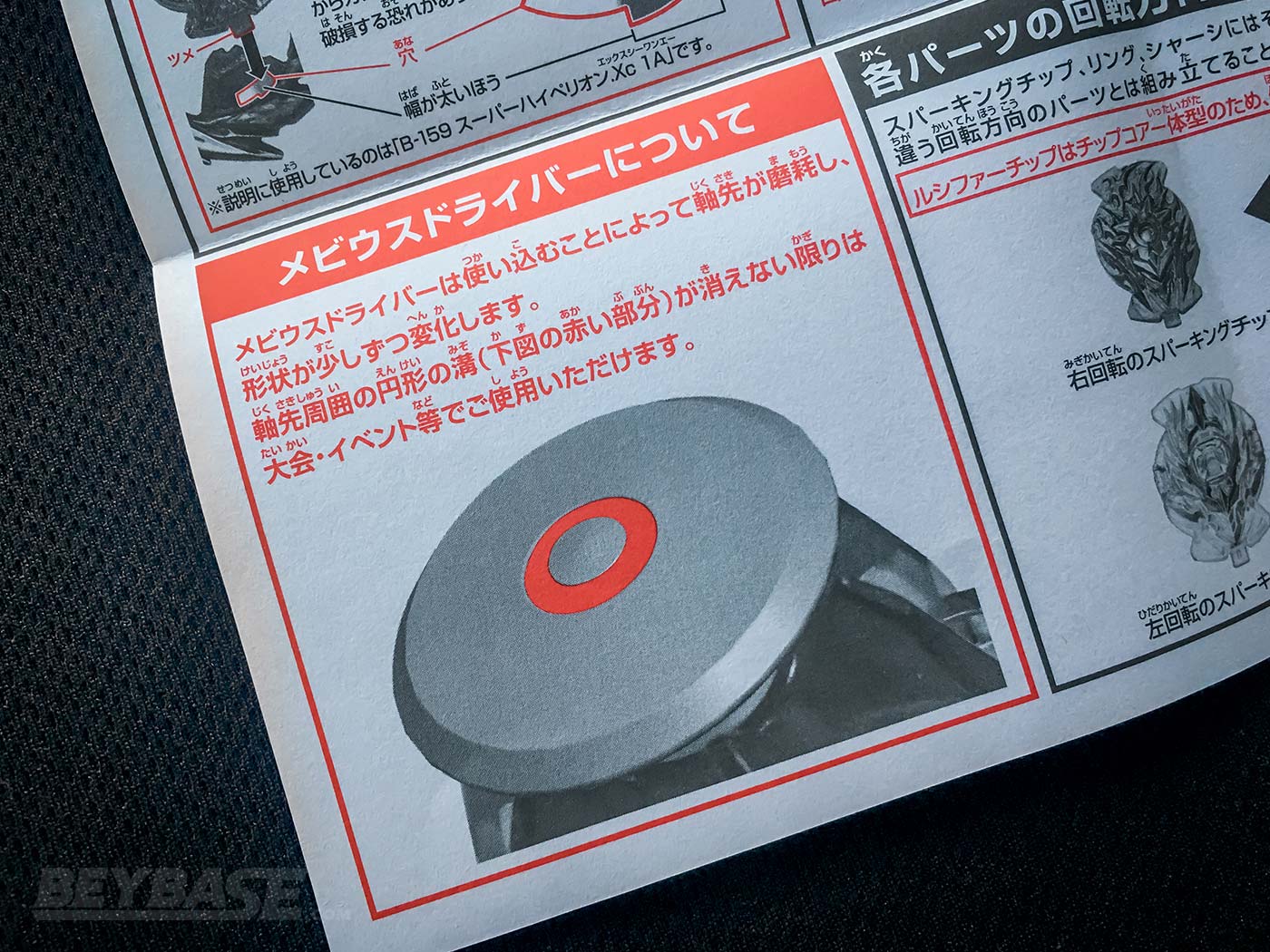
Essentially, if the circular ridge around the tip of Mobius is worn to the point where it is no longer visible, the Driver is no longer legal for tournament play. At this point it would effectively become flat.
Takara-Tomy has formal Driver wear regulations in place, but this marks the first time that they’ve ever included such a declaration directly with the product itself.
It’s a good sign that they are continuing to be vigilant with this and understanding of what would and wouldn’t be a positive addition to competitive play. I can see Mobius being worn down to this point able to stay upright even longer than it already does when new.
Recommended Beyblade Combo: Perfect Phoenix (Level Chip) Wheel Mobius
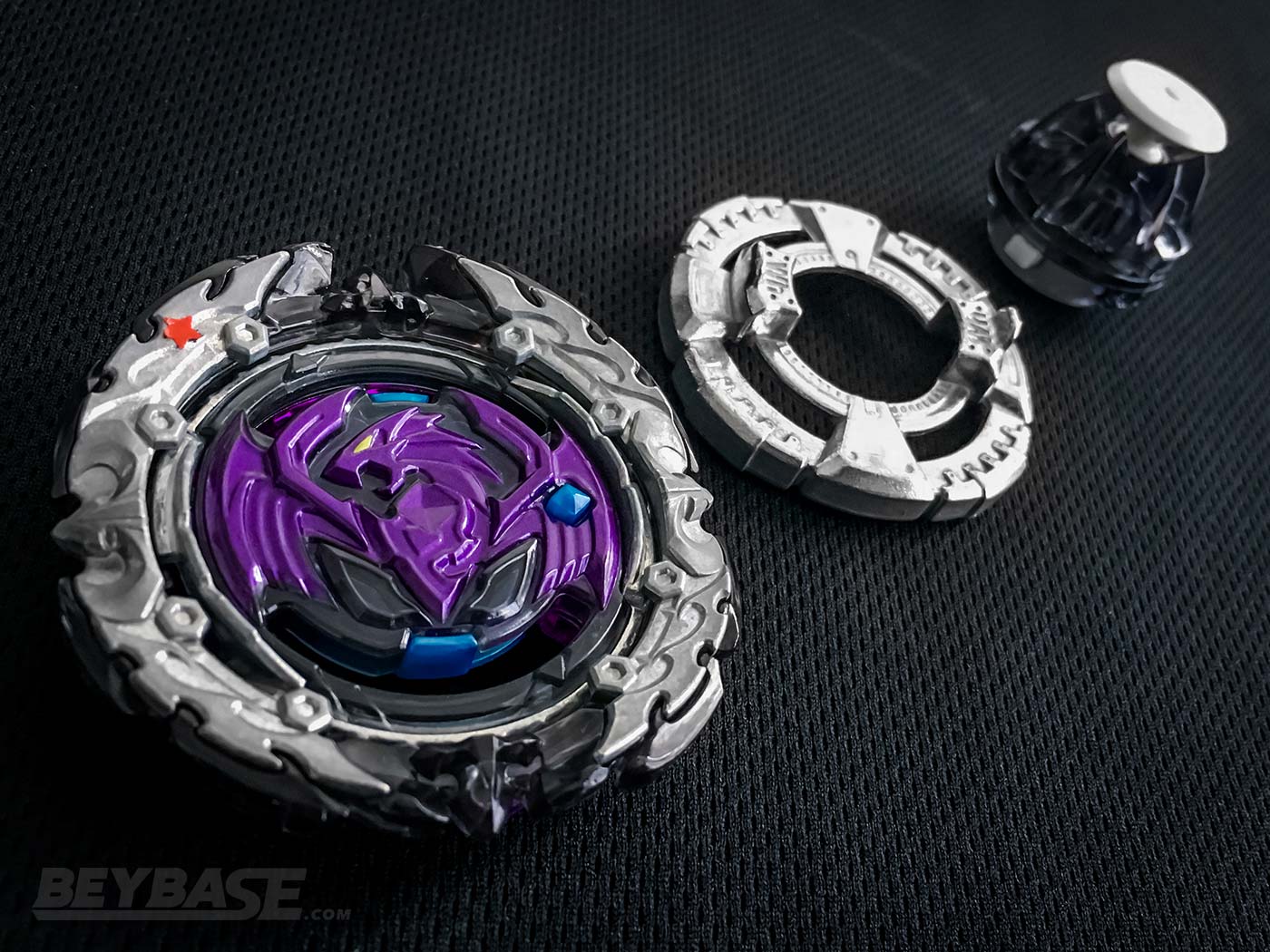
LC pP.Wh.Mb Combo Testing Video by JoJo [Jp0t]
See how Perfect Phoenix (Level Chip) Wheel Mobius performs in this video put together by JoJo [Jp0t]!
LC pP.Wh.Mb Strengths
- This combination is one of the best possible combinations in the game right now for opposite spin battles.
- The shape of the Perfect Phoenix Layer synergizes extremely well with the tall height of Mobius. pP increases the likelihood of the opponent resting below it because of the way the armor is raised above the Layer Body.
- The Wheel Disk has simultaneously best-in-class stamina and also does not interfere with the object of this combo like other wider Disks do. Because it is not super wide, opposing Beyblades do not have the opportunity to steal spin from it.
- The Mobius Driver has the best overall opposite spin performance in the game, matched closely only by a Bearing combination using the Wall Frame.
- Against right-spin attack types–an unfavourable situation–you will have to launch relatively hard to have any chance of outspinning your opponent. There is a high chance you will lose, but the movement Mobius produces when launched hard does still give you a chance to KO your opponent instead.
LC pP.Wh.Mb Weaknesses
- Although Perfect Phoenix is still the best right-spin stamina Layer in the game, this combination still cannot overcome Mobius’ poor same-spin performance. Don’t count on this combo to win you battles against pure right-spin stamina types.
- Being right spin, this combo will only do well against primarily left-spin stamina types. If you want to do well against right spin stamina types, try a left-spin Layer like Master or Lord as recommended below.
- Mobius doesn’t have the best KO Defense, so this combo can be susceptible to being knocked-out.
Want to build LC pP.Wh.Mb? You’ll need:
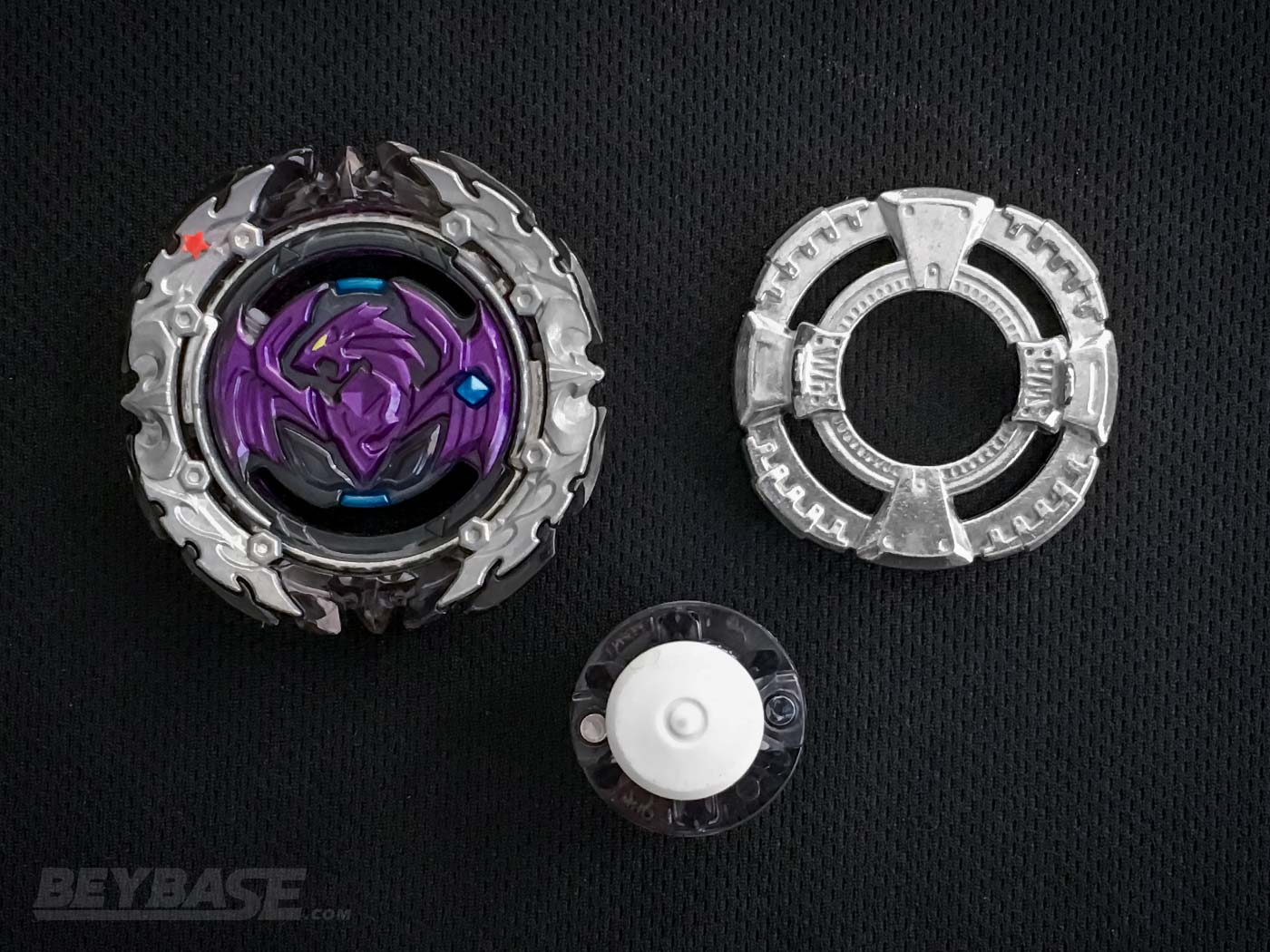
- Level Chip:
- Revive Phoenix (1 of the following):
- Dead Phoenix (1 of the following):
- Wheel (1 of the following):
- Mobius:
Recommended Alternative Products
- Master Layer Base:
- Lord Layer Base (1 of the following):
- Around Disk (1 of the following):
Should you buy Variant Lucifer Mobius 2D?
The short answer is: yes, to get the top-tier stamina Driver Mobius.
B-169 Starter Variant Lucifer Mobius 2D is a solid release.
Lucifer and Mobius are both competitive, 2D might be once the rubber blades are worn down.
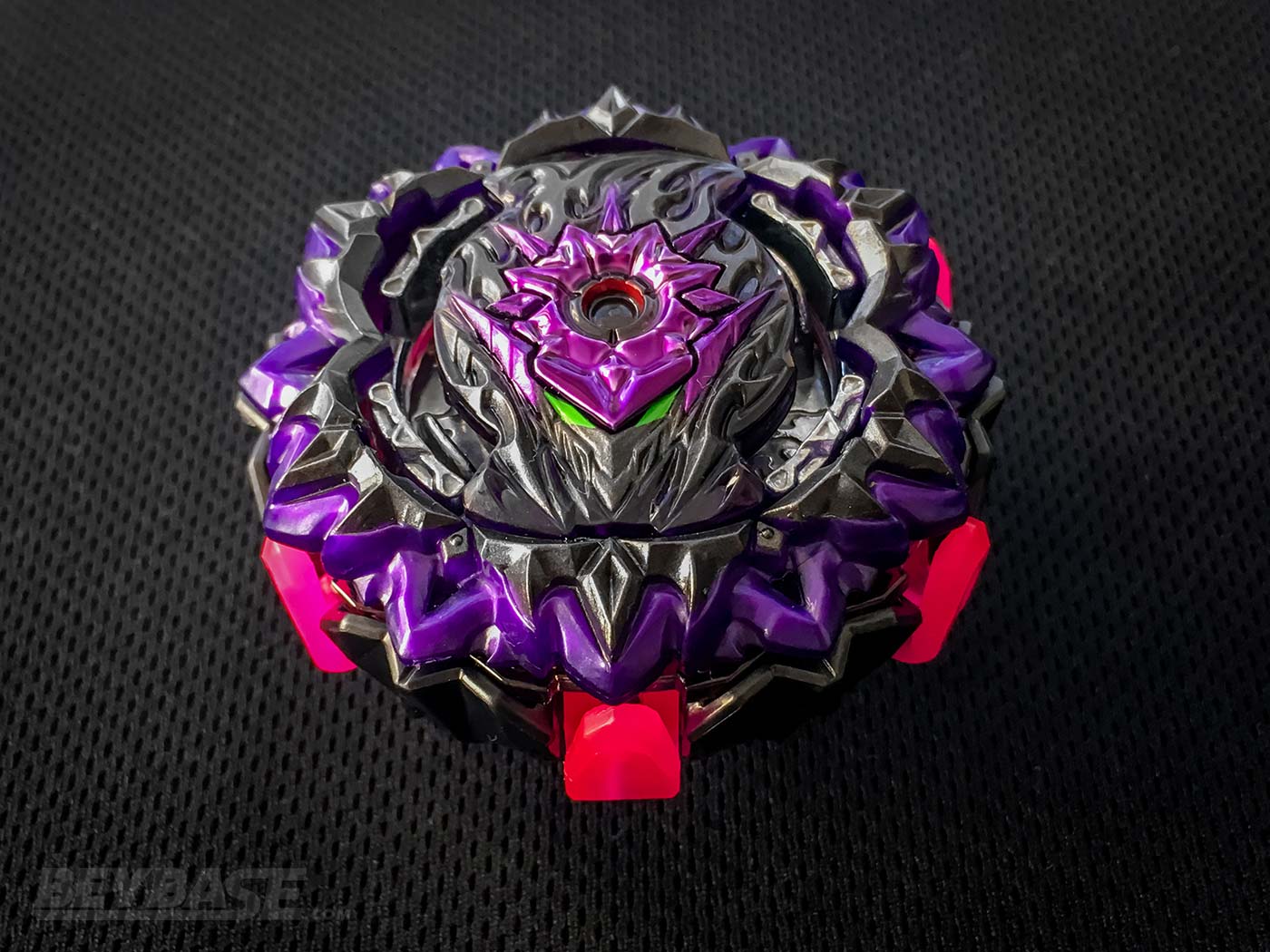
It not only features a slew of brand new innovative parts, but comes packaged with a black Sparking BeyLauncher, making it a great value for both new and veteran players alike.
Five years into the longest running Beyblade series to date–Beyblade Burst–Takara-Tomy still hasn’t solved the fundamental problems facing the concept of pure defense types.
The glaring flaw of the Variant Ring–its low weight–brings some serious questions to mind about Takara-Tomy’s design process as well, but nevertheless they’ve continued to produce innovative and new concepts to the series this far in. That’s worth commending.
The Good & The Bad
The Good
+ It’s decent out of the box. While I always encourage players to experiment with different combinations, it is also important to note that Variant Lucifer Mobius 2D is a decent stamina combination for opposite spin battles out of the box.
+ The Lucifer Chip has built in metal, making it heavier than other Sparking Chips. It’s a good alternative to seeking out the very rare Metal Sparking Chip Core.
+ Mobius is a must-have for all competitive players. It sits arguably at the top of the tier list for opposite spin performance.
+ The awakened 2D Chassis shows potential for attack combinations. With all six rubber blades broken off it can deal some big hits. If you have the time to do it, it’s worth experimenting with his piece.
The Bad
– The Variant Ring is too light and basically useless.
– The 2D Chassis out of the box is poor defensively. The six rubber blades are extremely innovative and cool … but it just does not excel in much of anything. The blades cause it to lose stamina quicker than normal and it is often subject to critical hits from attack types which also contribute to depleting its stamina quickly.
– Mobius has poor same spin performance.
Final Score: 8/10
Where to Buy Variant Lucifer Mobius 2D
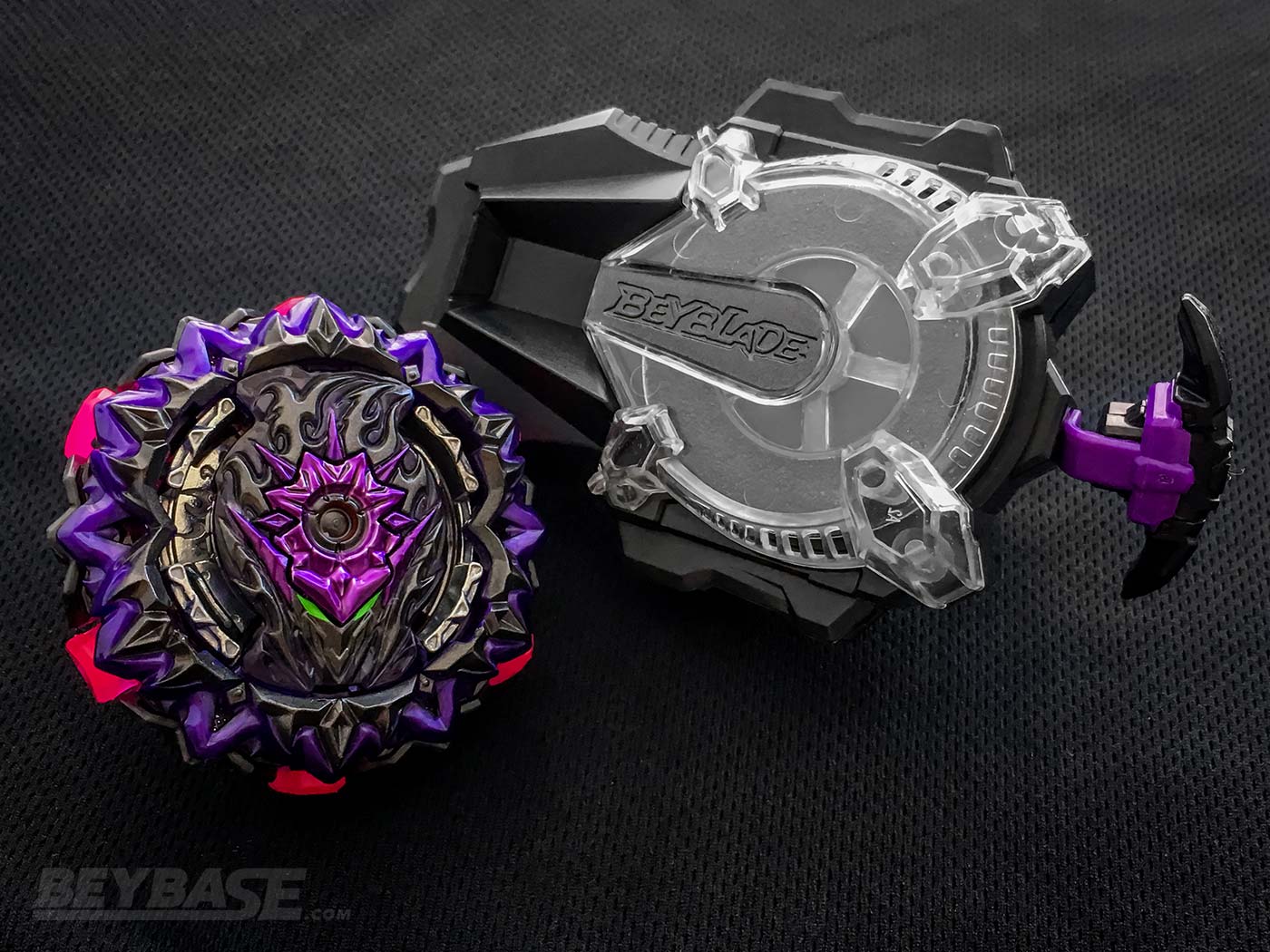
Heads up: If you buy something through some of the links on this post, you won’t pay any extra, but I’ll get a small commission. This helps me keep things running. Thanks for your support!
What do you think of Variant Lucifer Mobius 2D? Comment below!
If you’re thinking of picking up Variant Lucifer Mobius 2D and have any questions, feel free to ask below and I’ll do my best to answer.
And if you’ve already picked it up, I’d love to hear about your thoughts and testing experiences with it. What combinations do you like to use with Variant, Lucifer, Mobius, and 2D with?
Photo Gallery
6 thoughts on “Is Variant Lucifer Mobius 2D the best Beyblade Burst defense type?”
Comments are closed.


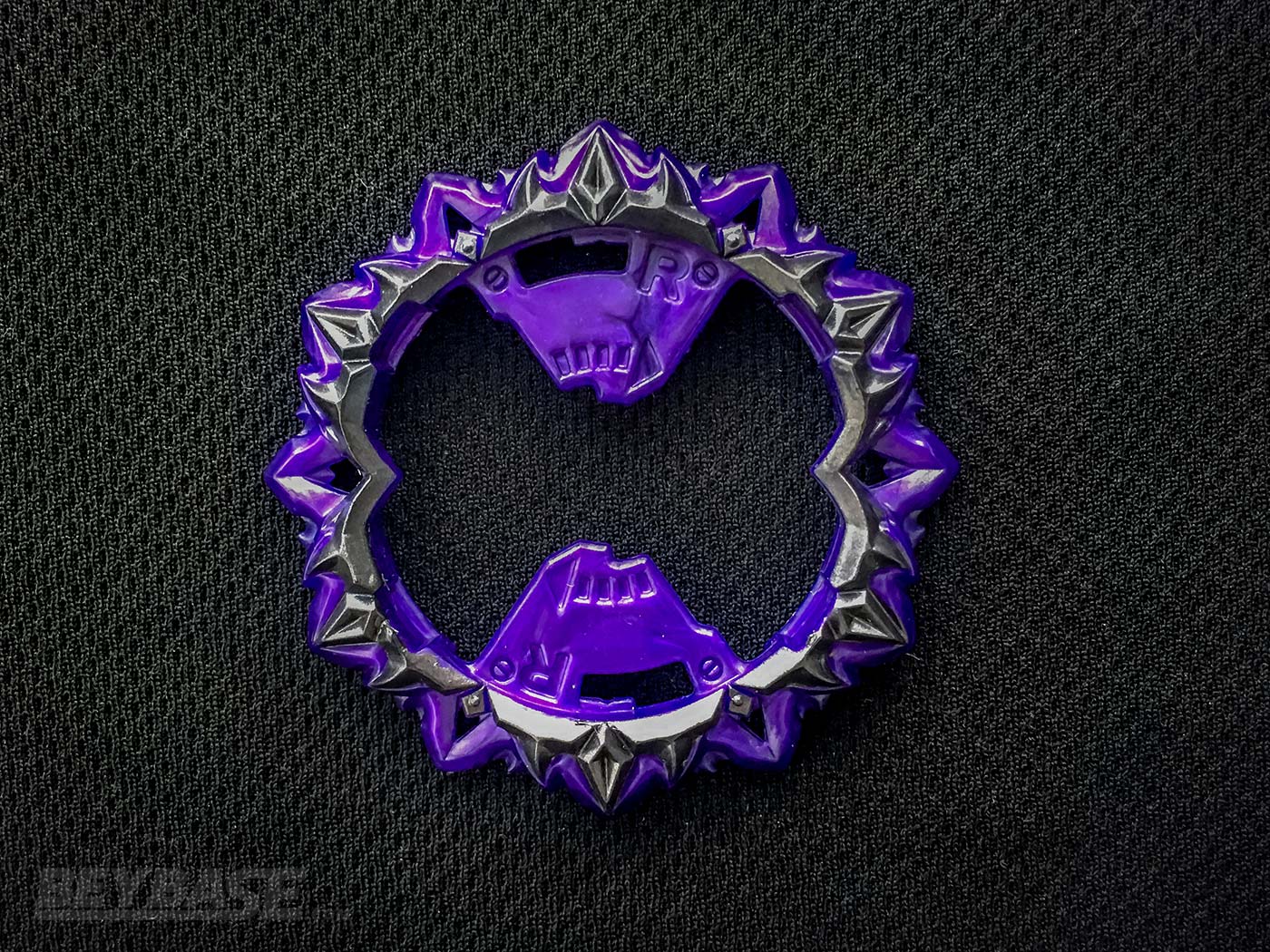

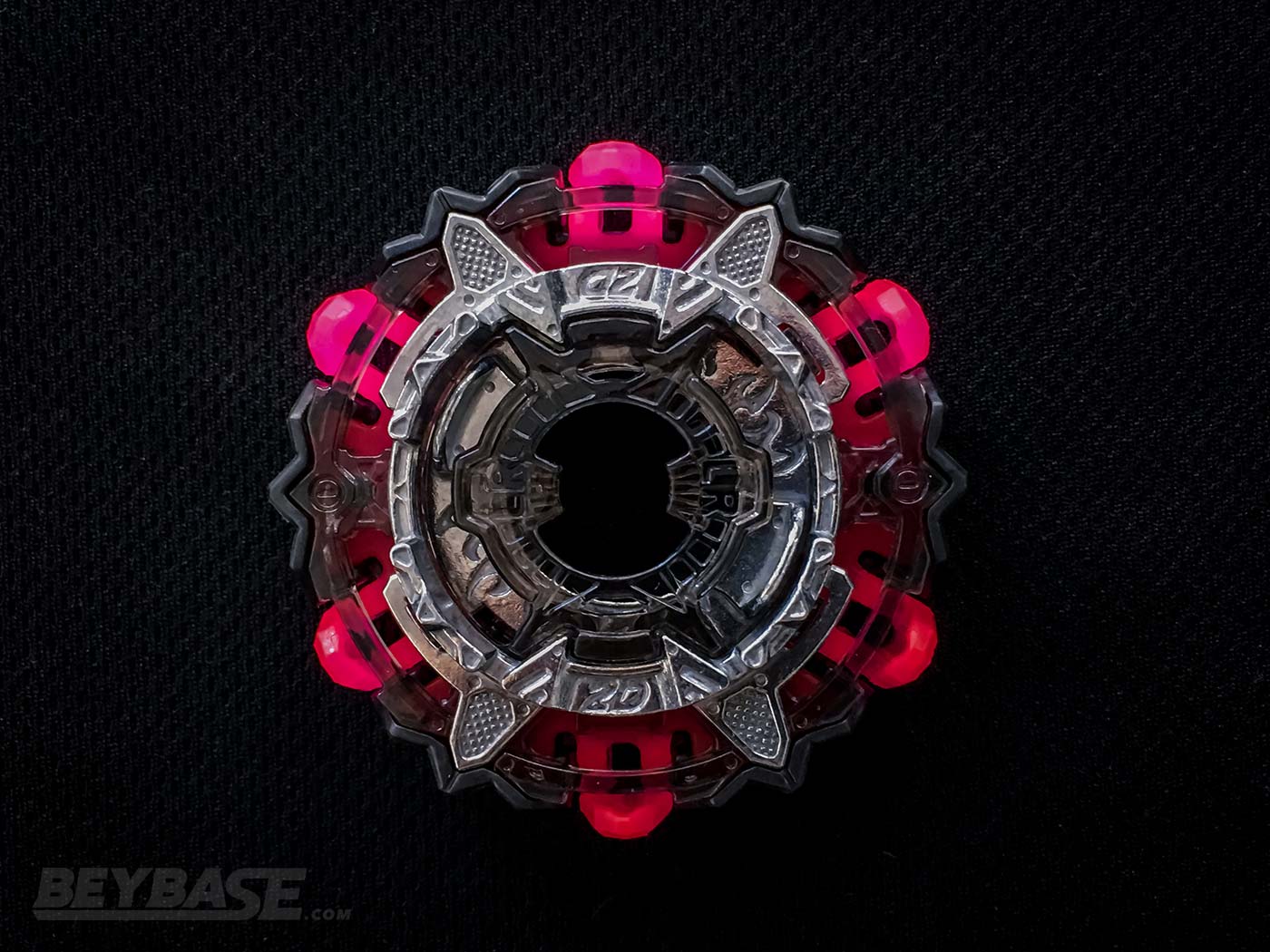

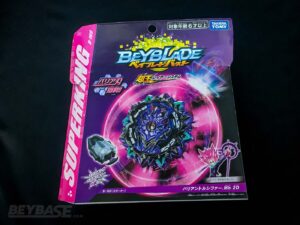
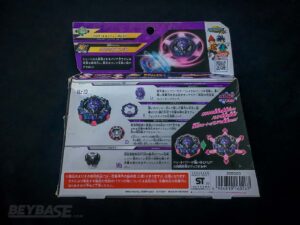
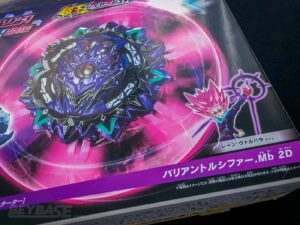
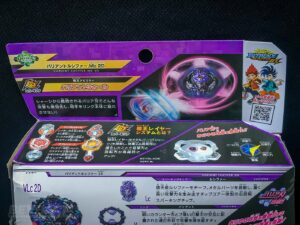
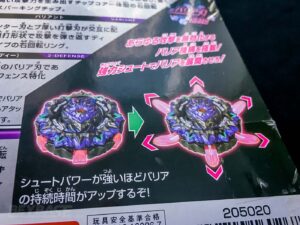
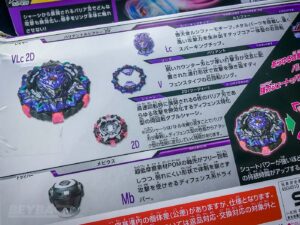
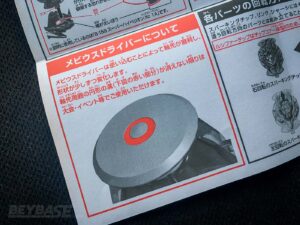

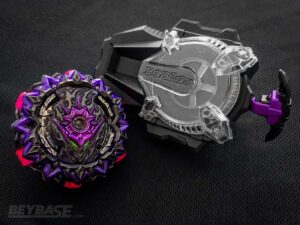

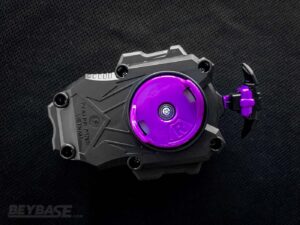
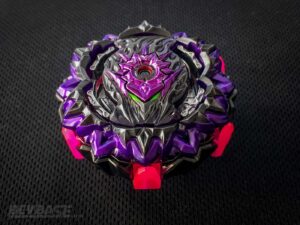

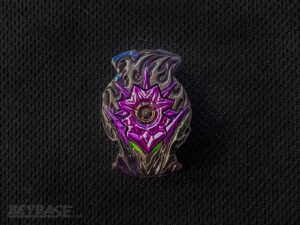
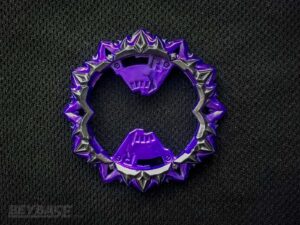
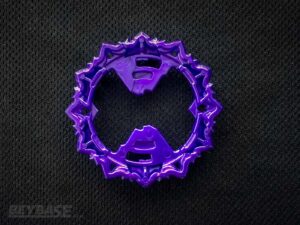


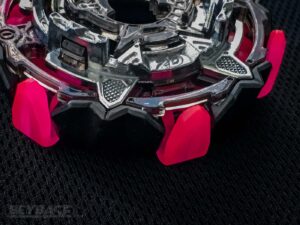

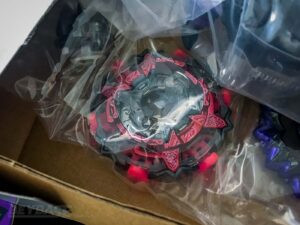
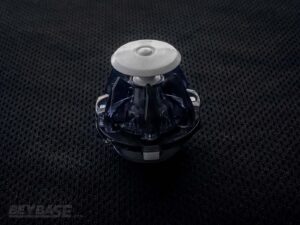
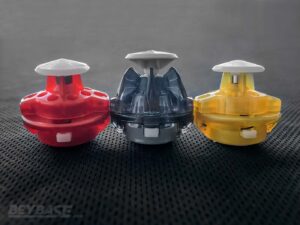
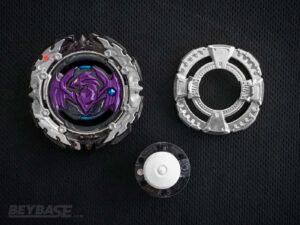
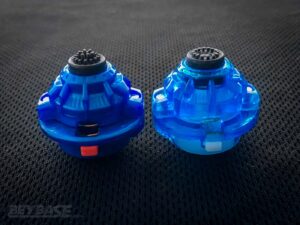

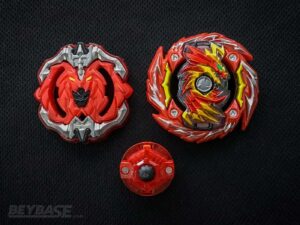
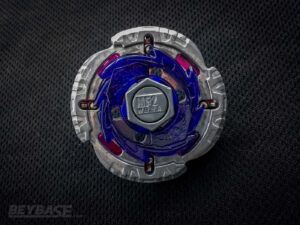

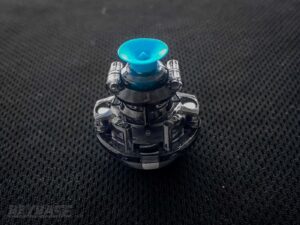
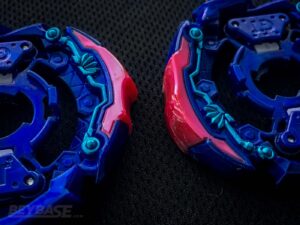
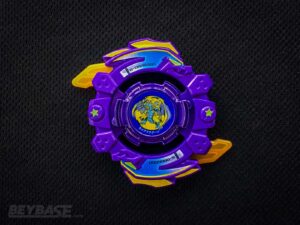
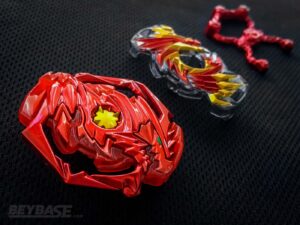
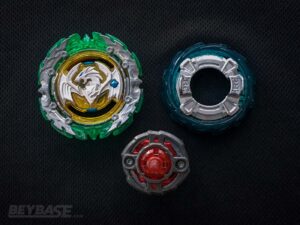
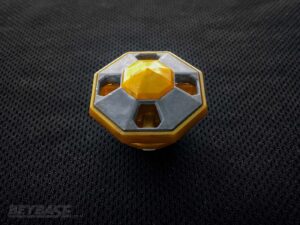
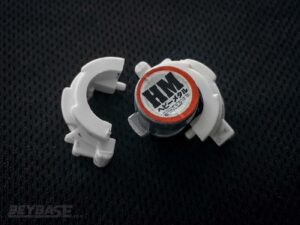

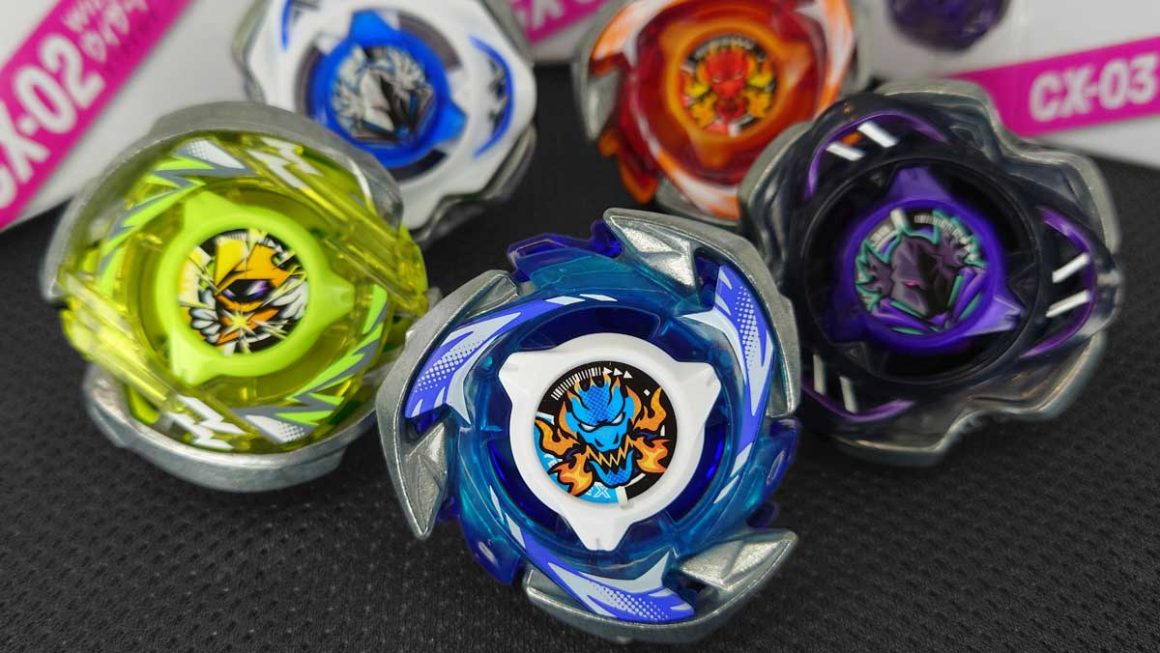
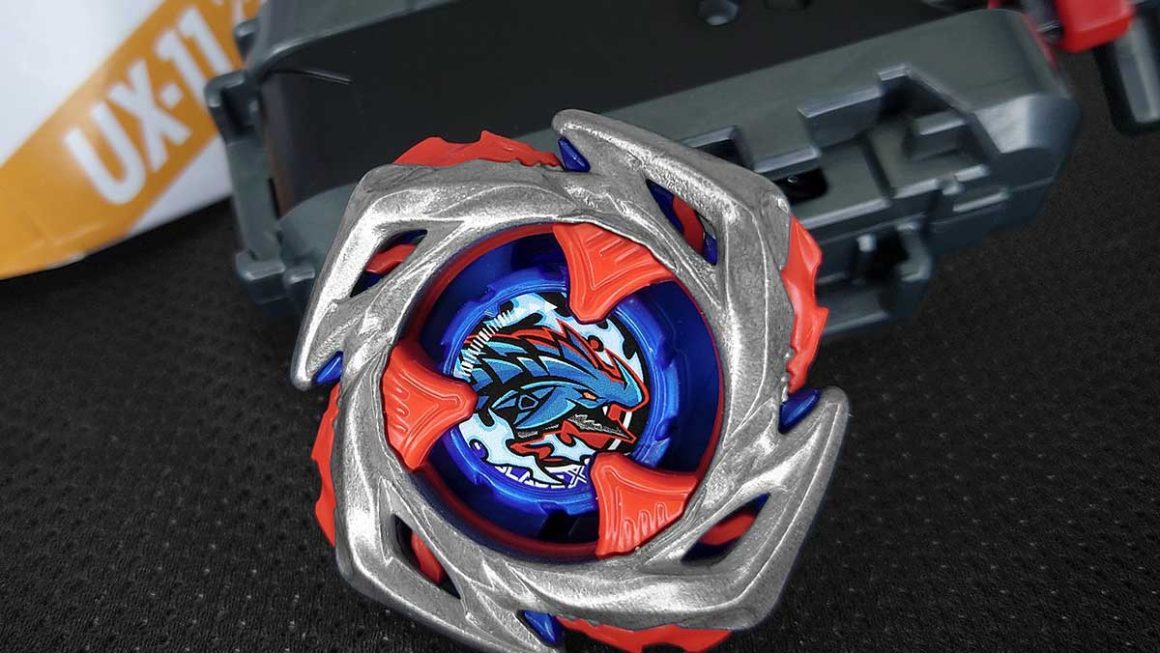
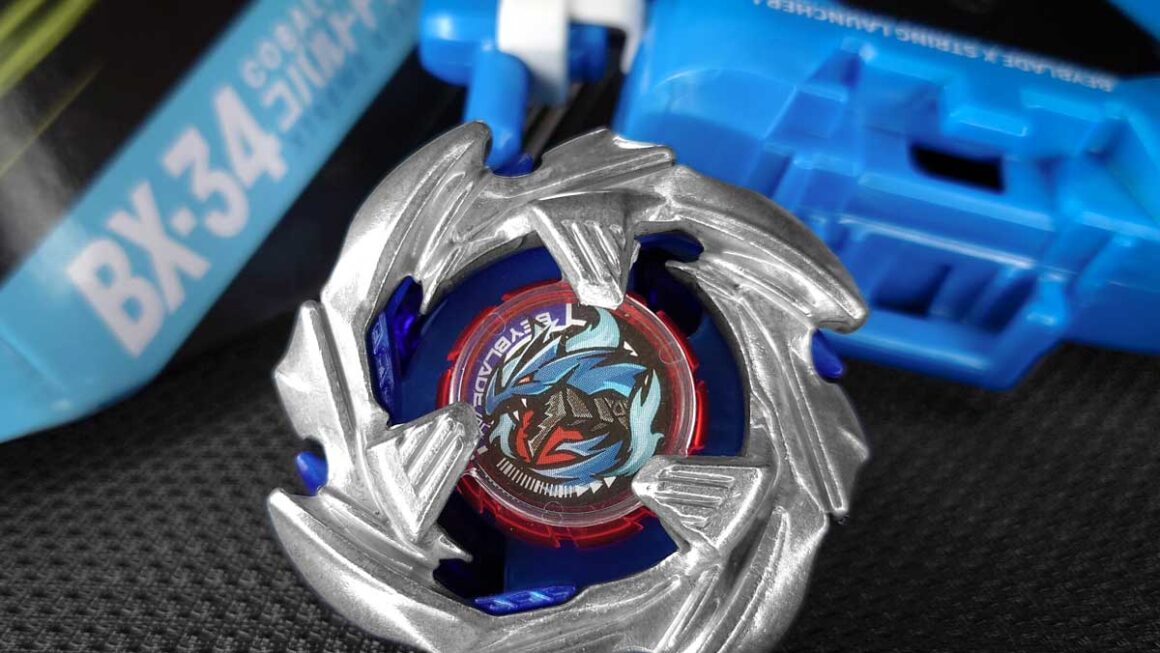
Kei, I love your posts. Thanks for giving such a detailed explanation on Lucifer! I think that the best part of lucifer like you said is mobius, but Im wondering what the difference will be with WBO rules and Japan’s rules. Will WBO rules for the wear on mobius be different from japan? Just curious to know. Also, while we’re on that, does WBO allow “awakening” on hybrid and ignition? I just want to know before I decide if I want to do that or not.
Finally, I wanted to do the same combo you did earlier, but my dead armor broke…
Instead, I found that Brave Lucifer/Diabolos Mobius 2S actually worked fairly well. 2s is slim enough to allow the combo to lean on the opponent bey in opposite spin and braves rubber as well as the bey’s weight helps a little to kill the opponents stamina in same spin. This is just a recommendation of mine. You don’t need to try it out.
Either way, once again, I love reading your posts. I think you give great information every time and you put a great amount of time and effort to do this. You rock!
I think your posts are very detailed, but I am still torn between Bearing and Mobius. I feel that Mobius has very good potential but is not as good as a worn Bearing, I also feel that 00Turn is a safer choice than 00Wall or Vanguard for Bearing. 00Wall is excels in opposite spin match ups but Vanguard excels in same spin. I was experimenting with a Lord Spriggan/Master Longinus 00Wall/Vanguard Bearing and I realised that my Master Longinus Vanguard/00Wall Bearing combo was being Burst by Judgement combos (But not Zwei) and the Lord Spriggan was getting ringed out and lost stamina due to the scrape. I was trying to find a balance between 00Wall and Vanguard. After testing numerous times, I realised 00Turn(With the protrusions facing the same spin as i found out putting the protrusions the opposite way killed stamina) was worth a try, and somehow the Bearing combos were able survive better, Master Longinus took less damage, and Lord Spriggan managed to survive longer. I don’t exactly know why it is so, but I do not think Mobius combos would use similiar combos to Bearing. I think Takara Tomy Banned it if the gap disappears because over time it may wear down to fit into the stadium better and may have better performance than Bearing, but i am quite happy they increased the spring lock as the weak spring for Bearing was kind of a bummer when it was released. Your articles are great and i hope you’ll Keep it up!
Please, although my comment is in Portuguese-BR, answer me!
Eu fiquei confuso,após o desgaste da esfera que tem no Mobios,quando ele fica plano,não é permitido usar em campeonatos oficiais?
Hmmm I really like this release I like the limited format so I use Shadow Amaterios 00 Wall Mobius littraly the Limited version of Pp.Wh.Mb
Hey Kei, was just wondering if it is true that the Solomon chip is heavier than Lucifer…
Also, what beys would you recommend for me to get?
Hey Aeneas. That’s right, Solomon is heavier than Lucifer.
As for what Beyblades you should get, maybe this article would help! https://beybase.com/best-beyblades-to-buy/